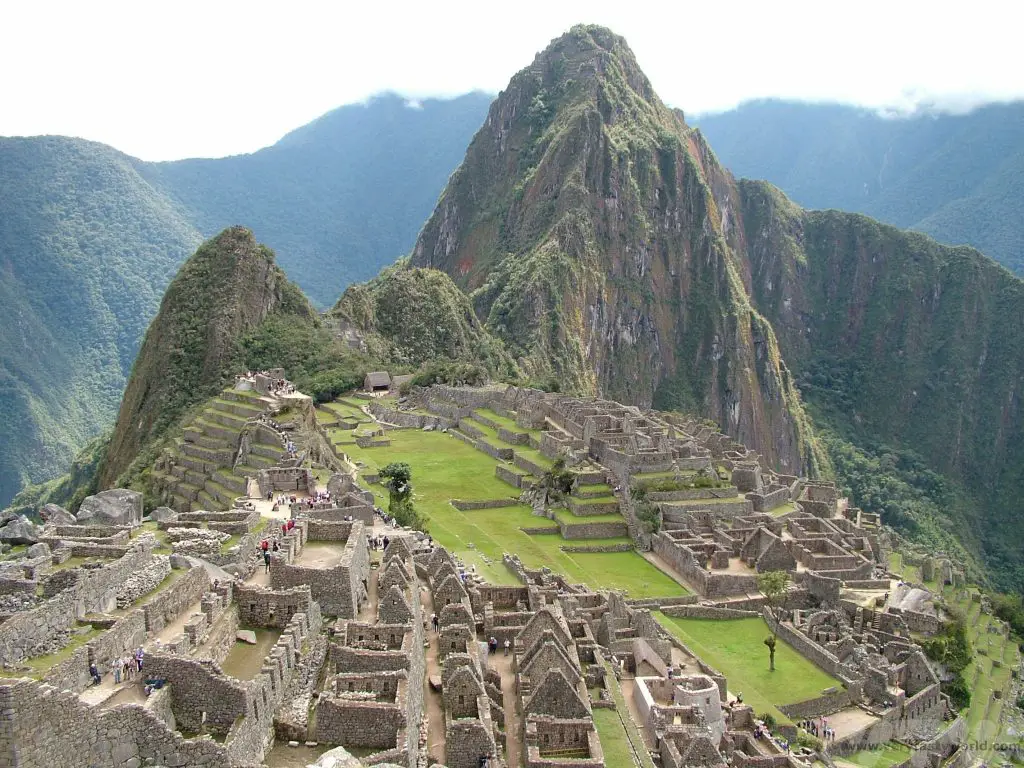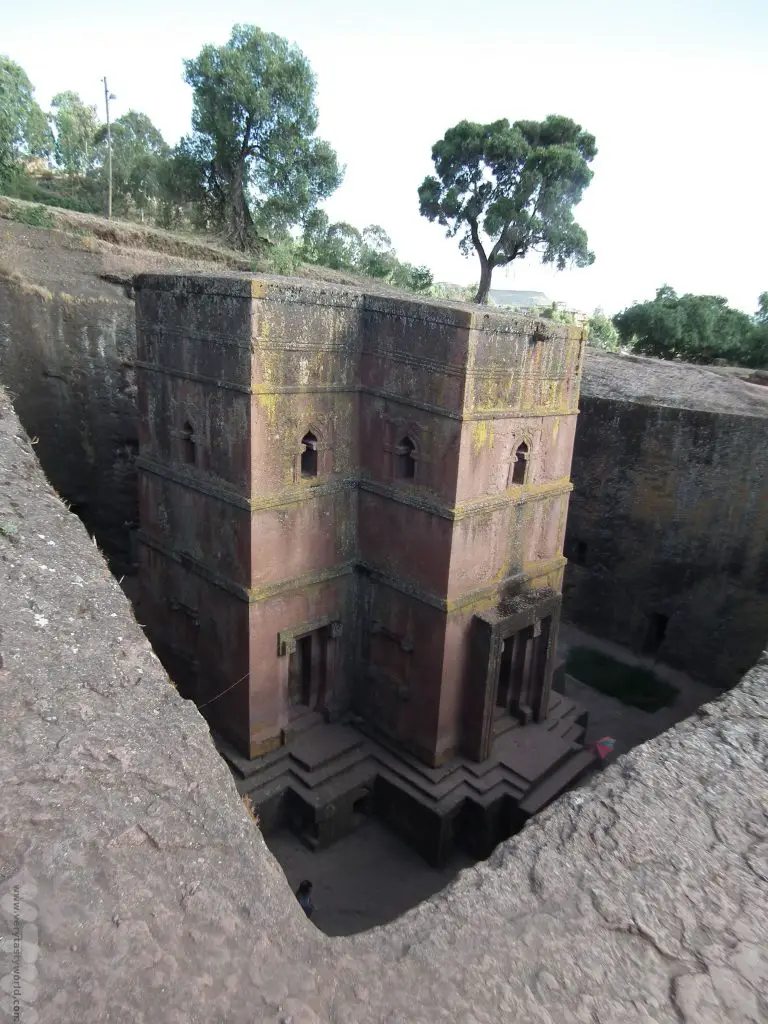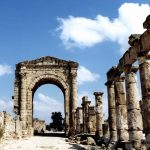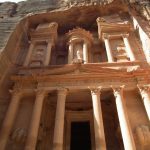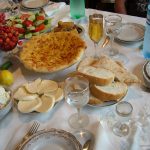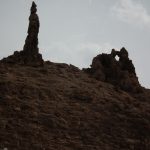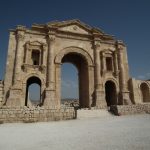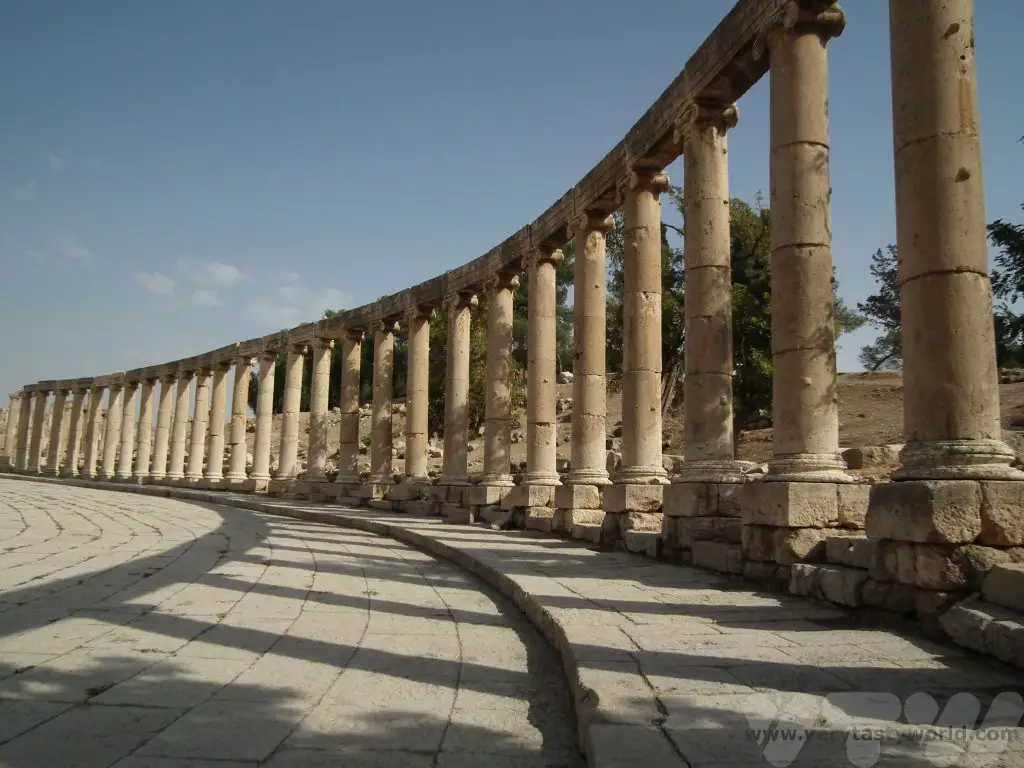Home » Countries » Middle East and Eurasia » Jordan
Category Archives: Jordan
Visit Petra in Jordan
The Rose Red City
There are many magnificent archaeological sites in the world and the Rose Red City of Petra is undoubtedly one of the greatest. It had long been an ambition to visit and it was top of our list when exploring Jordan. Here is a guide to a visit to Petra.
The most famous image of Petra that of Al-Khazneh, The Treasury (the one you see in the film Indiana Jones and the Last Crusade) and we knew that we would walk through a dramatic canyon, known as As-Siq, to reach it. What we didn’t realise was quite how extensive the site is.
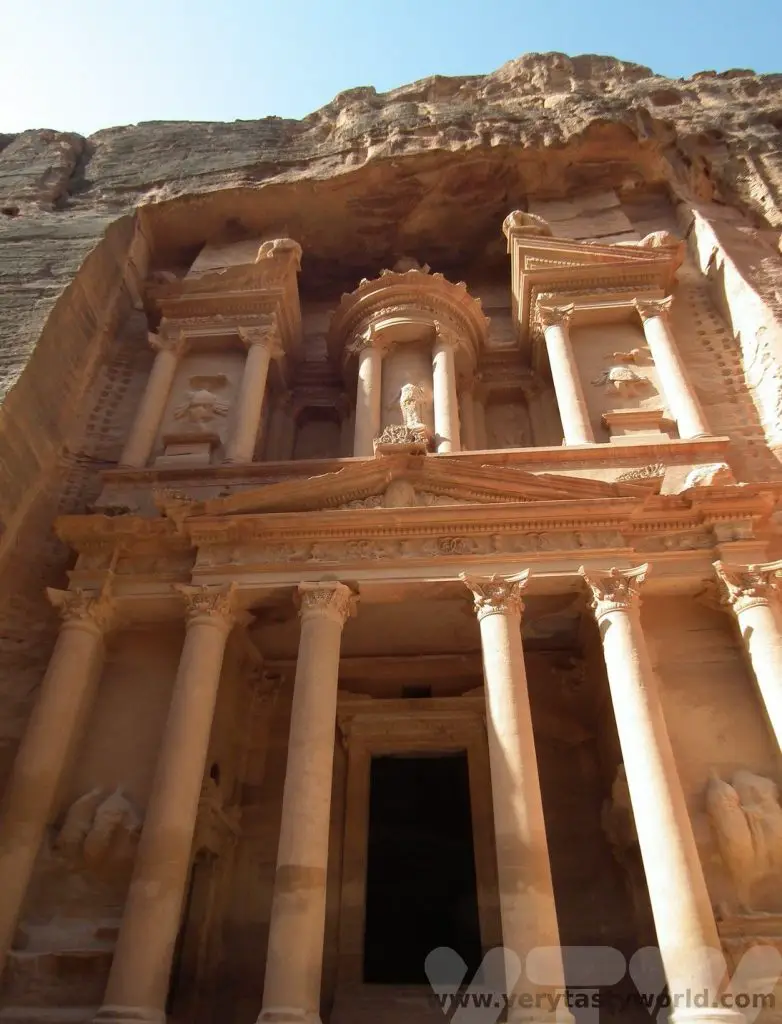
The History Of Petra
Petra was built by the Nabateans, an ancient Arab tribe, around the 1st Century BCE. The Nabateans were involved with caravaneering, trading in goods from all over the Middle East and Far East, and they became very wealthy protecting the region’s trade routes. Goods came from as far as China and India. What was fascinating about the Nabateans was that they were a clever, enlightened people. They believed in cultural inclusivity and appropriated technology from all over the world, absorbing influences from the places they traded with. You can see many different architectural styles throughout Petra.
In 106 CE the city was overtaken by the Romans who renamed it Arabia Petraea. The city did thrive under Roman rule for many years but its importance as a trade route declined as sea trading routes developed and became more important for transporting goods. It was significantly damaged by an earthquake in the 4th Century CE. It declined further during the Byzantine era and the city eventually was abandoned became ‘lost’ for centuries. It was re-discovered by explorer Johann Ludwig Burckhardt in 1812.
Visit Petra In Jordan – Practicalities
The site is located around 240km from Jordan’s capital city, Amman. The time it takes to reach the area does vary depending on the traffic, especially in Amman, which can be quite congested, but also the route you take. It’s around three hours by car on the modern desert highway or five hours on the King’s Highway. It is possible to do a day trip to Petra from Amman by bus, leaving early in the morning and returning in the evening, but the visit would be very rushed. It is also possible to reach the site using a hire car (the driving would be easy except in Amman where the roads are quite chaotic) or via a private tour – there are many options available.
We had travelled to Petra via Mount Nebo and the Dead Sea having spent some time in Amman, and after visiting the Roman city of Jerash.
You can’t stay in Petra itself (edit – that is, there are no hotels in Petra), but there is a town called Wadi Musa nearby. Our hotel was about a ten minute walk from the site entrance at Wadi Musa, which was a further kilometre away from the start of the Siq. Included in the ticket price is a horse ride to the Siq, which we declined. We don’t feel comfortable using animals when we are travelling as we can never be sure how they are treated, so avoided these. We prefer to walk anyway. Since we visited, an initiative has been established to use electric vehicles that will replace the horse-drawn carriages.
We had two full days to explore. We needed them. You cannot enter the site without purchasing a ticket at the visitor’s centre at Wadi Musa and we recommend finding a guide for at least part of your visit. We found the most delightful guide at the visitor’s centre who was with us the first morning; he showed us Petra’s main features and explained a lot of the history. We spent the rest of the time there exploring the site for ourselves. (This link will take you to current entrance fees and costs for guides.)
The Siq
Just before the entrance to the Siq you can see the Obelisk Tomb and the Bab as-Siq Triclinium.
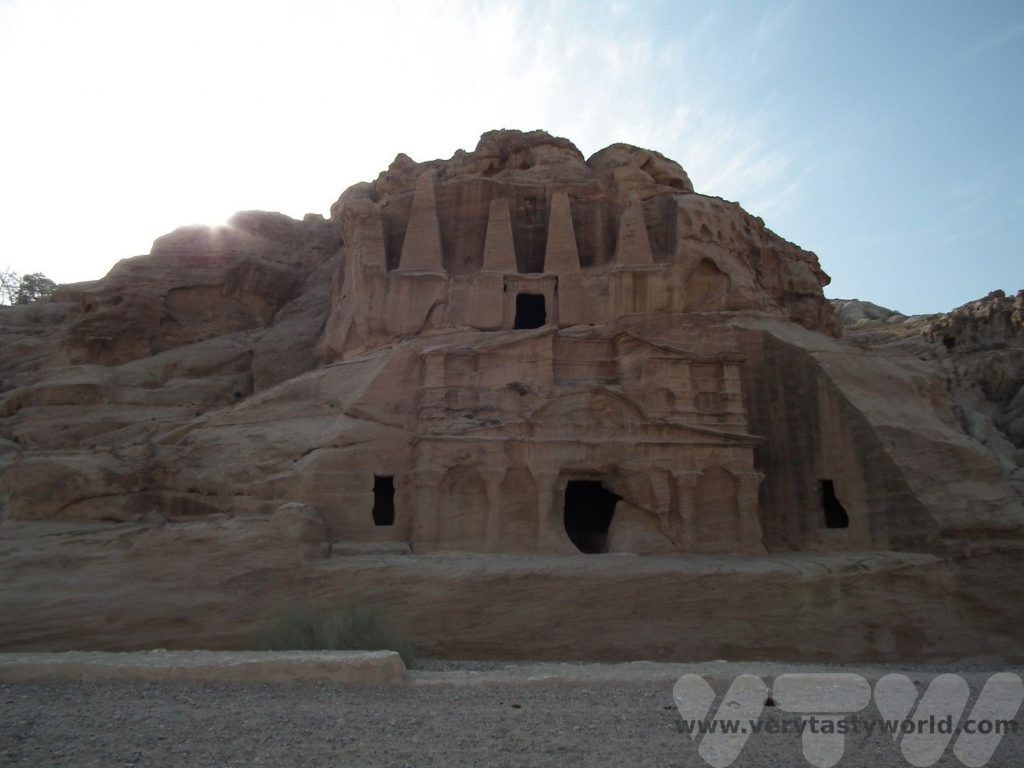
Then you enter the gorge itself. The Siq is about 1200 m long. It is deep (up to 80m in places), at times narrow, and stunningly beautiful. You can see all sorts of natural features, rock formations and fossils, as well as the remains of carvings showing caravans and camels.
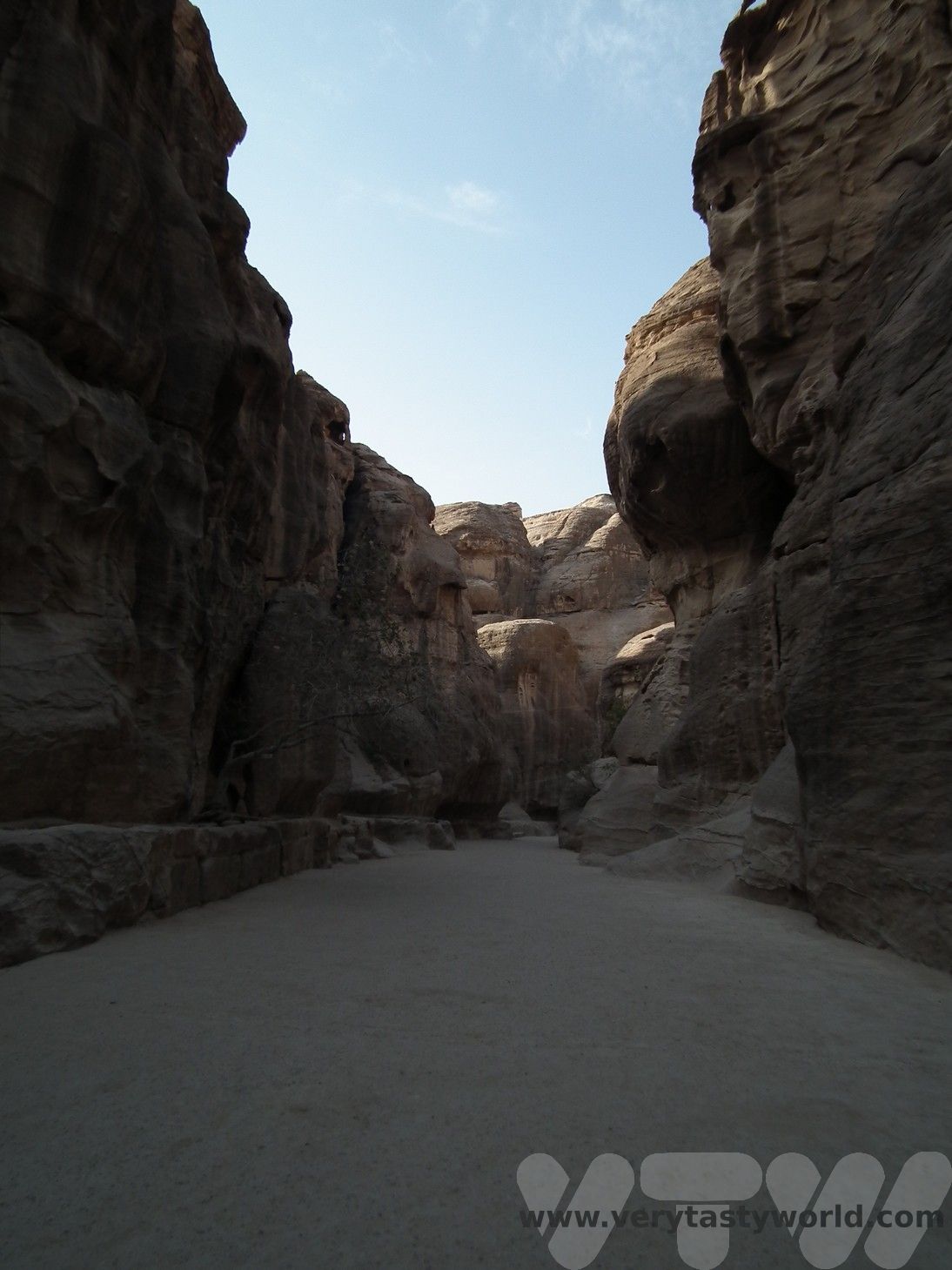
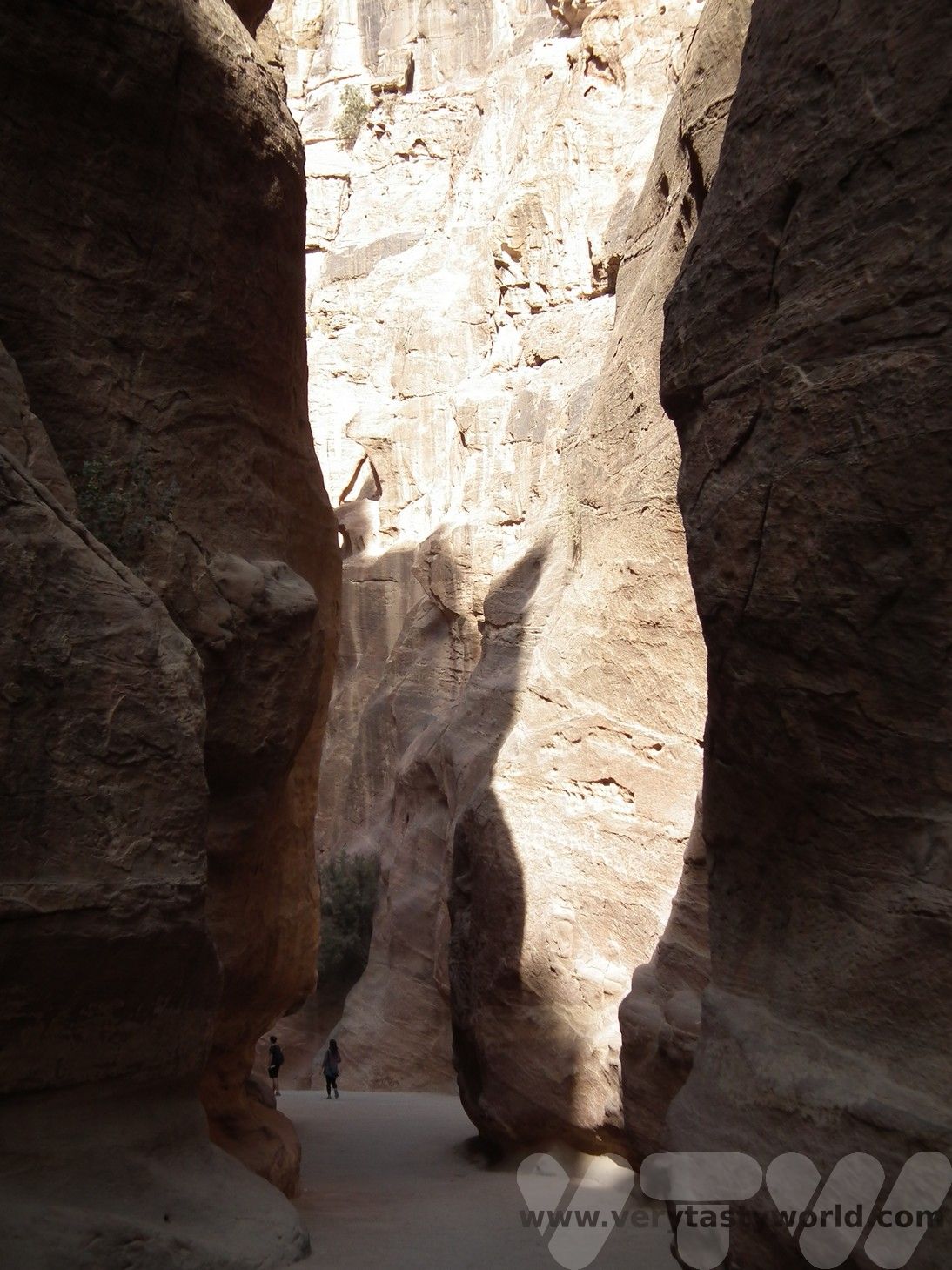
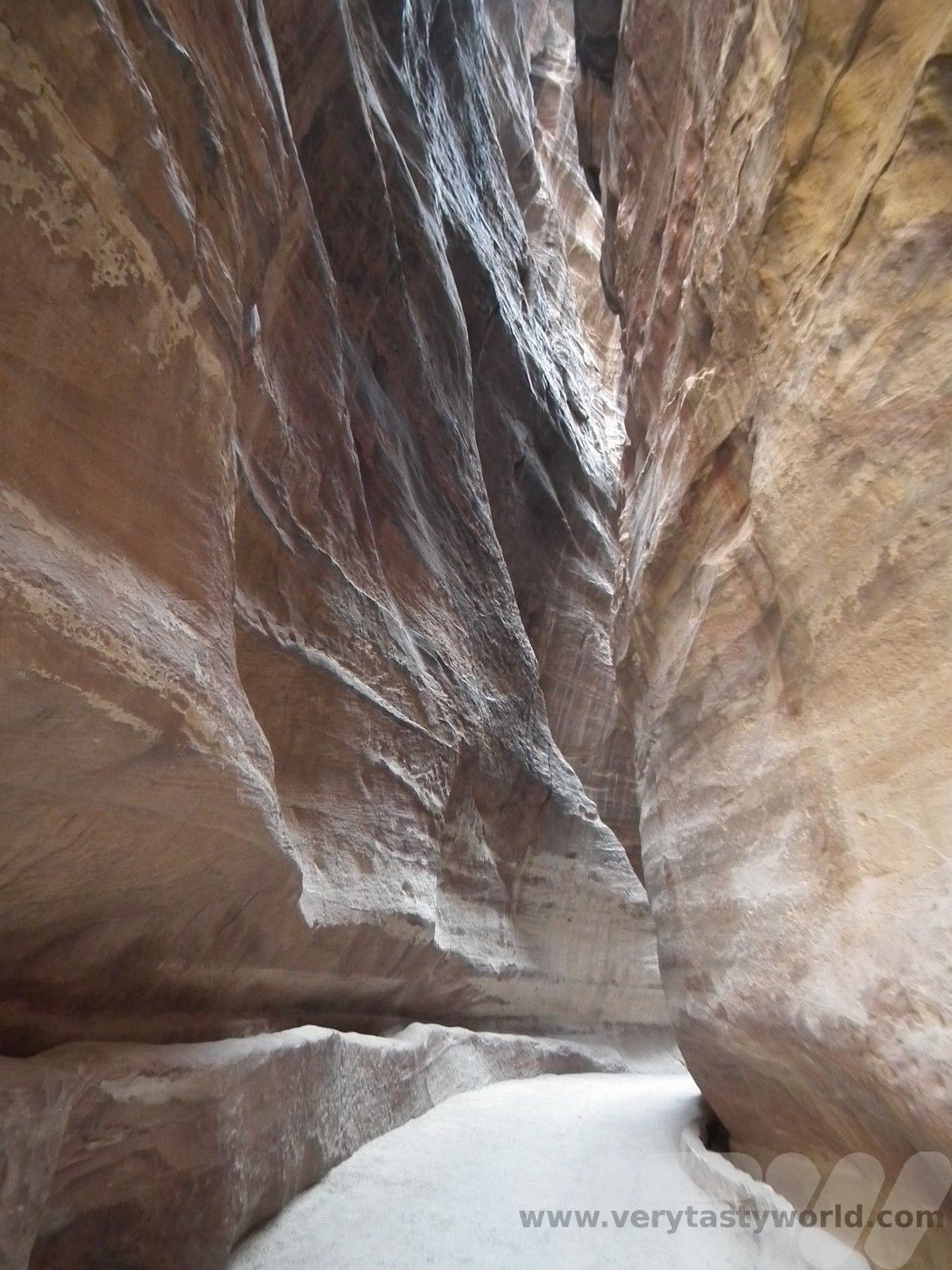
The photo shows drainage channels carved into the rock, inspired by Chinese bamboo irrigation channels, which carried water to Petra.
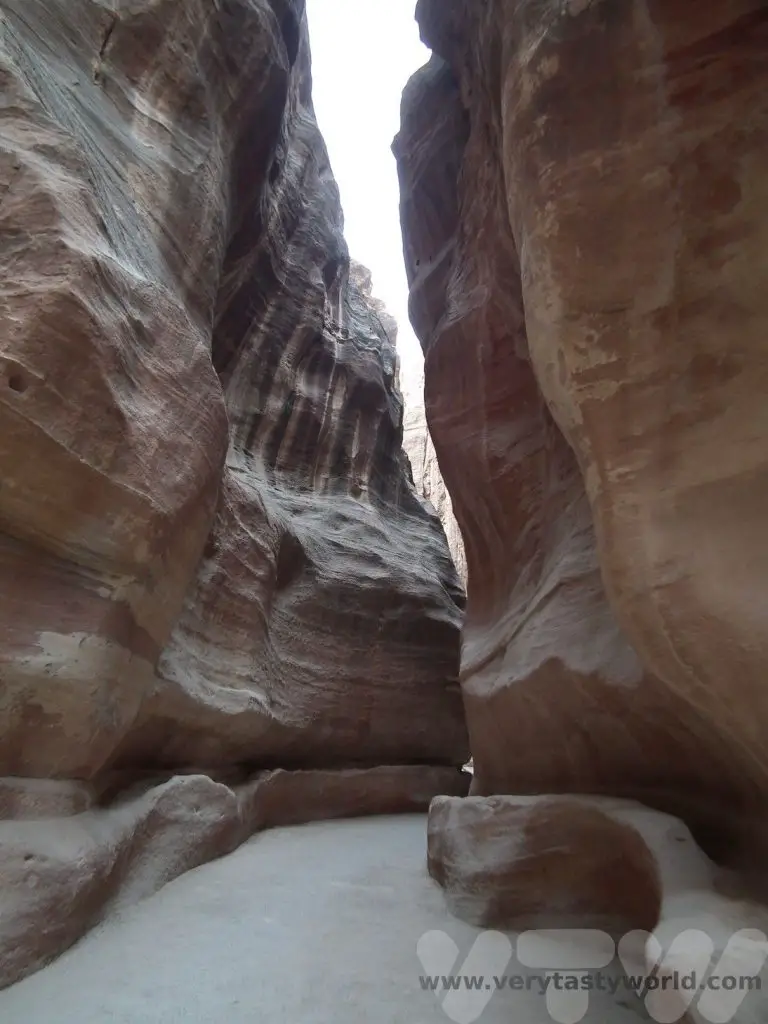
Then, at the end of the walk, you get a tantalising glimpse…
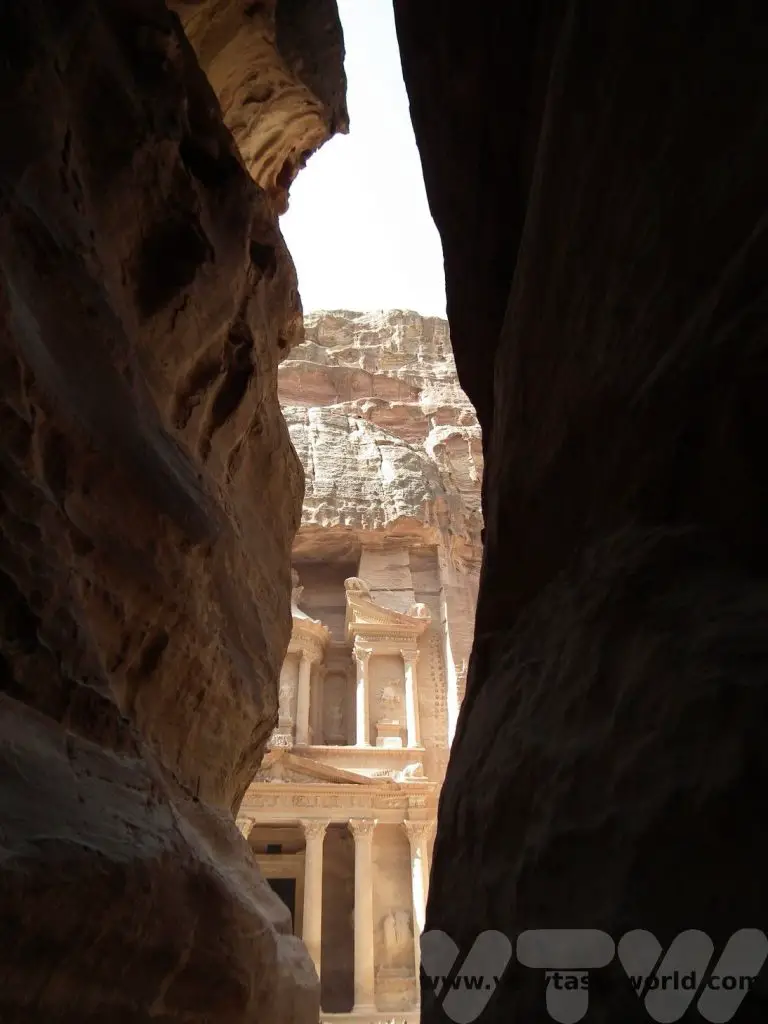
…of the Treasury, Al Khazneh. It’s actually a tomb of a 1st century Nabatean king. It’s about 30m wide and over 40m high. As with all the tombs at Petra, it was carved from the top down. (This process is similar to the amazing underground churches of Lalibela in Ethiopia.) You can see lots of indentations in the sandstone at the side of the structure. No-one is really sure about what they were for, but they could have been used by the craftsmen and masons for climbing to the top.
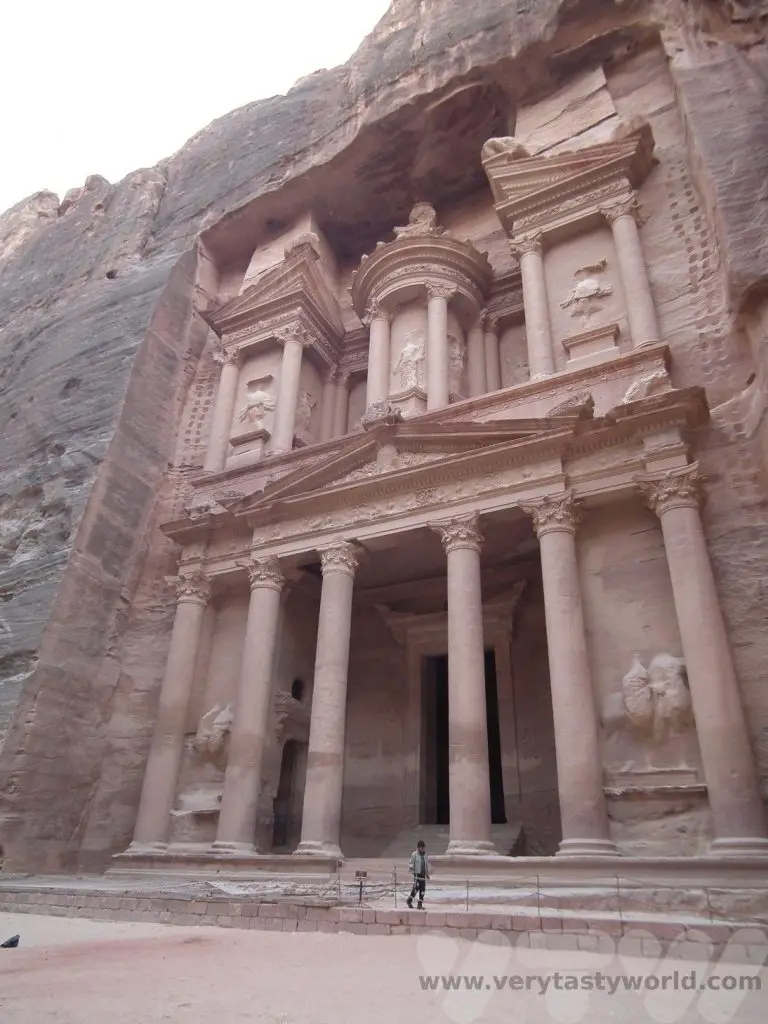
Exploring Petra
The Treasury is just the start of the site. It’s the only place you are not allowed to go inside. Everywhere else is open for exploration. There are no restrictions and no barriers so you need to take care.
From the Treasury you follow the Street of Facades, which has rows of tombs, all intricately carved from the rock.
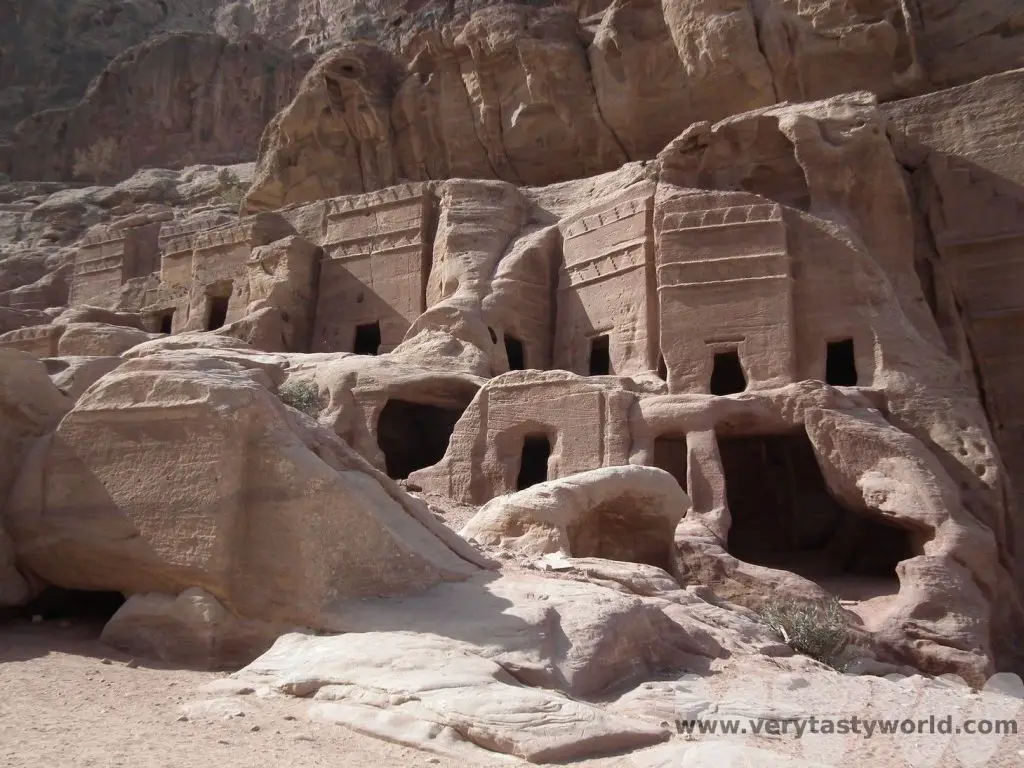
At the end of this street is the amphitheatre, carved into the rock, which appears to have a Roman influence. Its maximum capacity was around 7000 people.
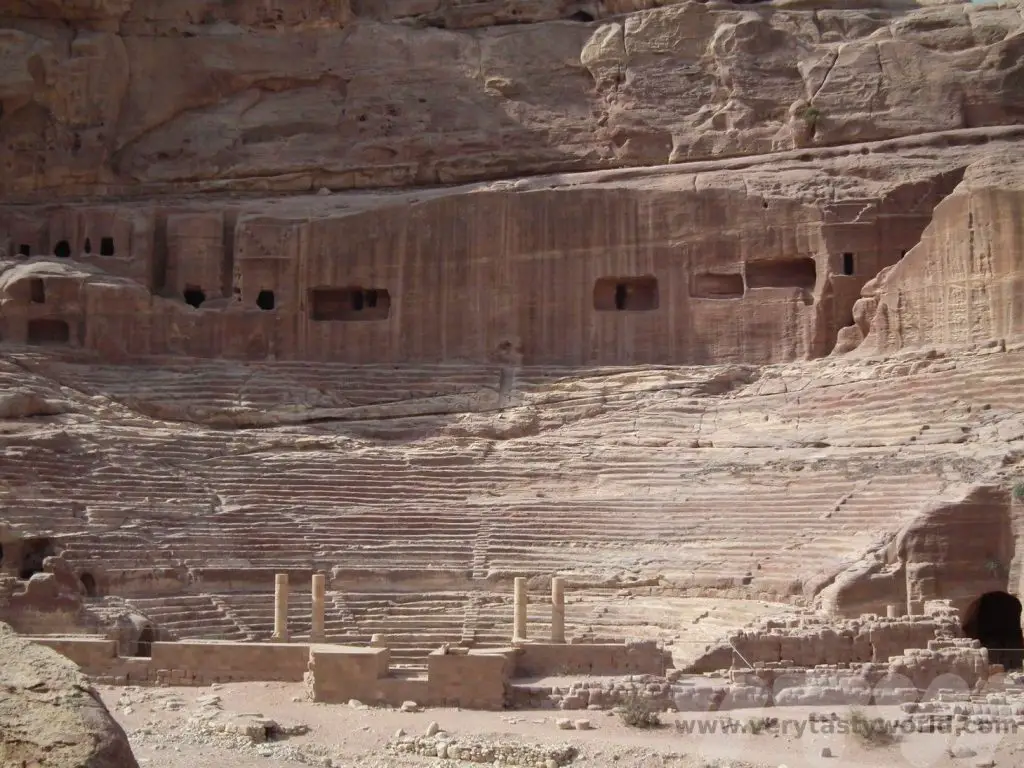
At the end of the street you can see further Nabotean tombs to the right…
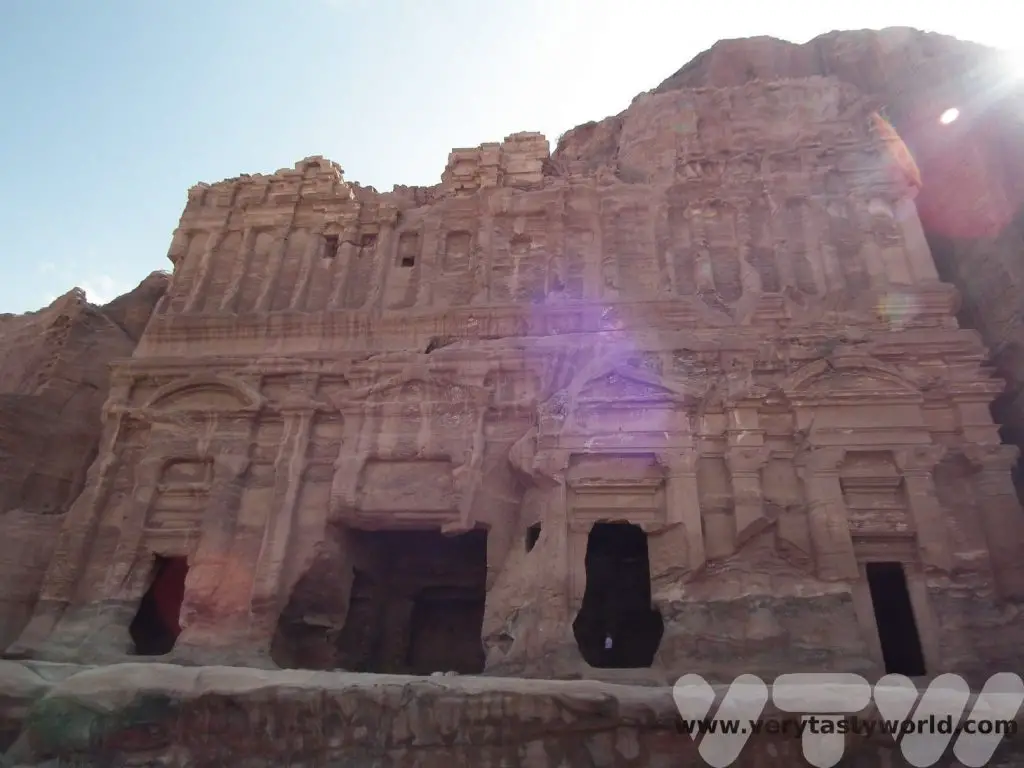
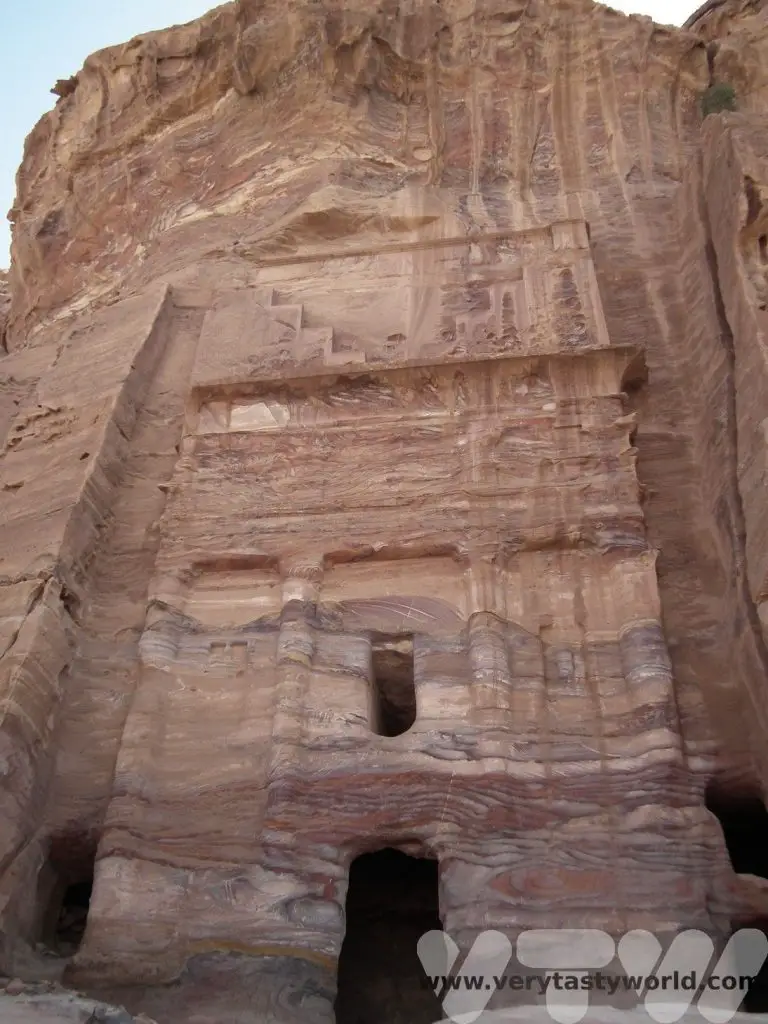
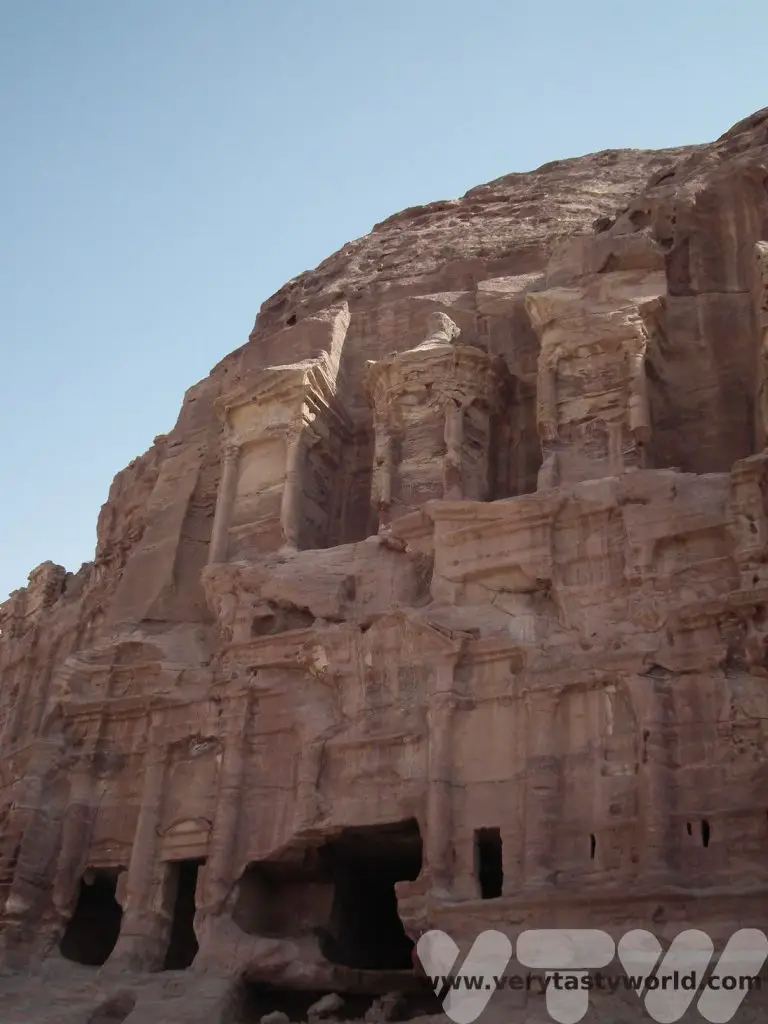
If you make a left turn you will walk along a colonnaded street, with marble pavement much of which is still preserved, which was effectively the city centre. It would have been lined with temples and public buildings.
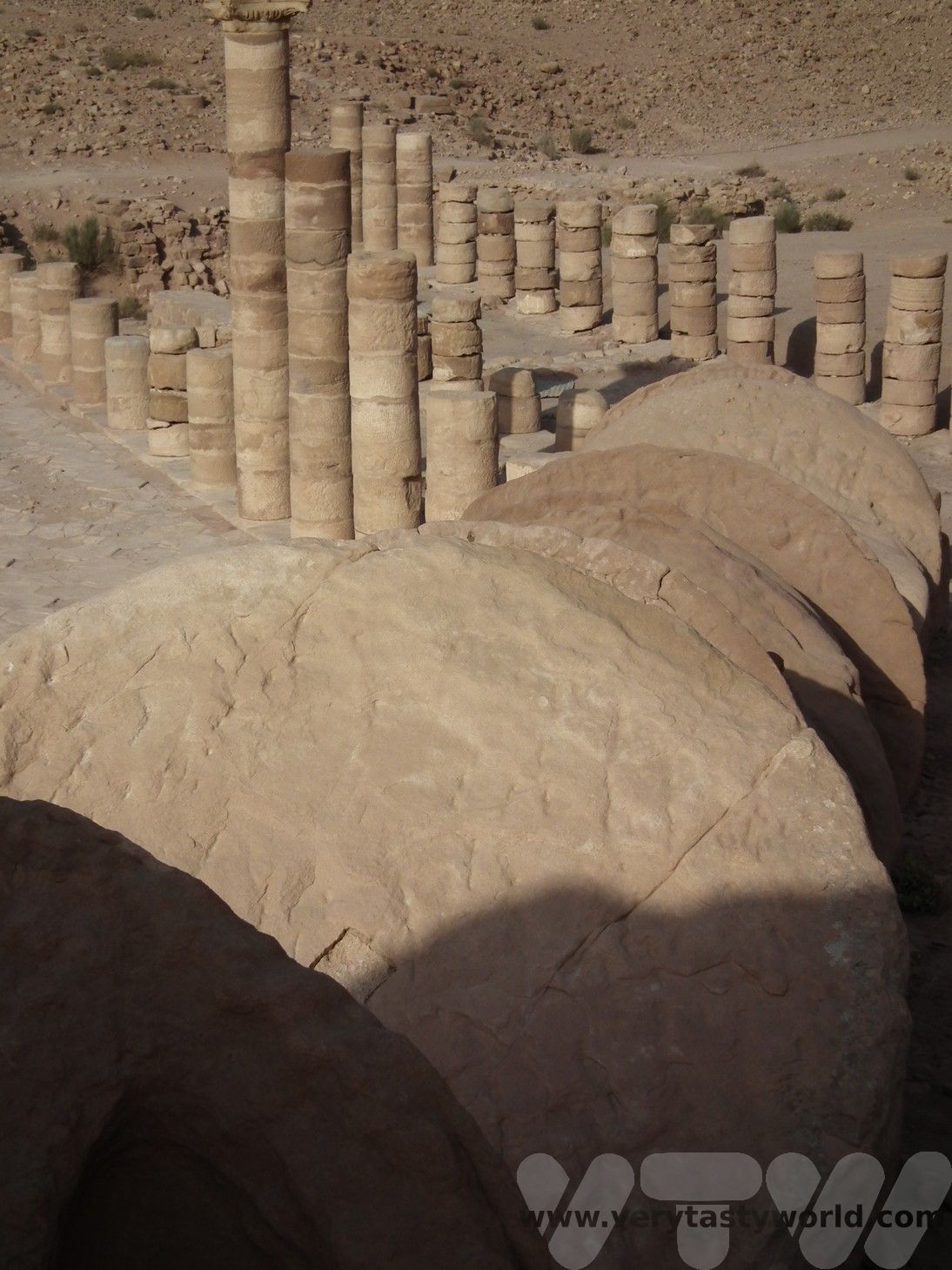
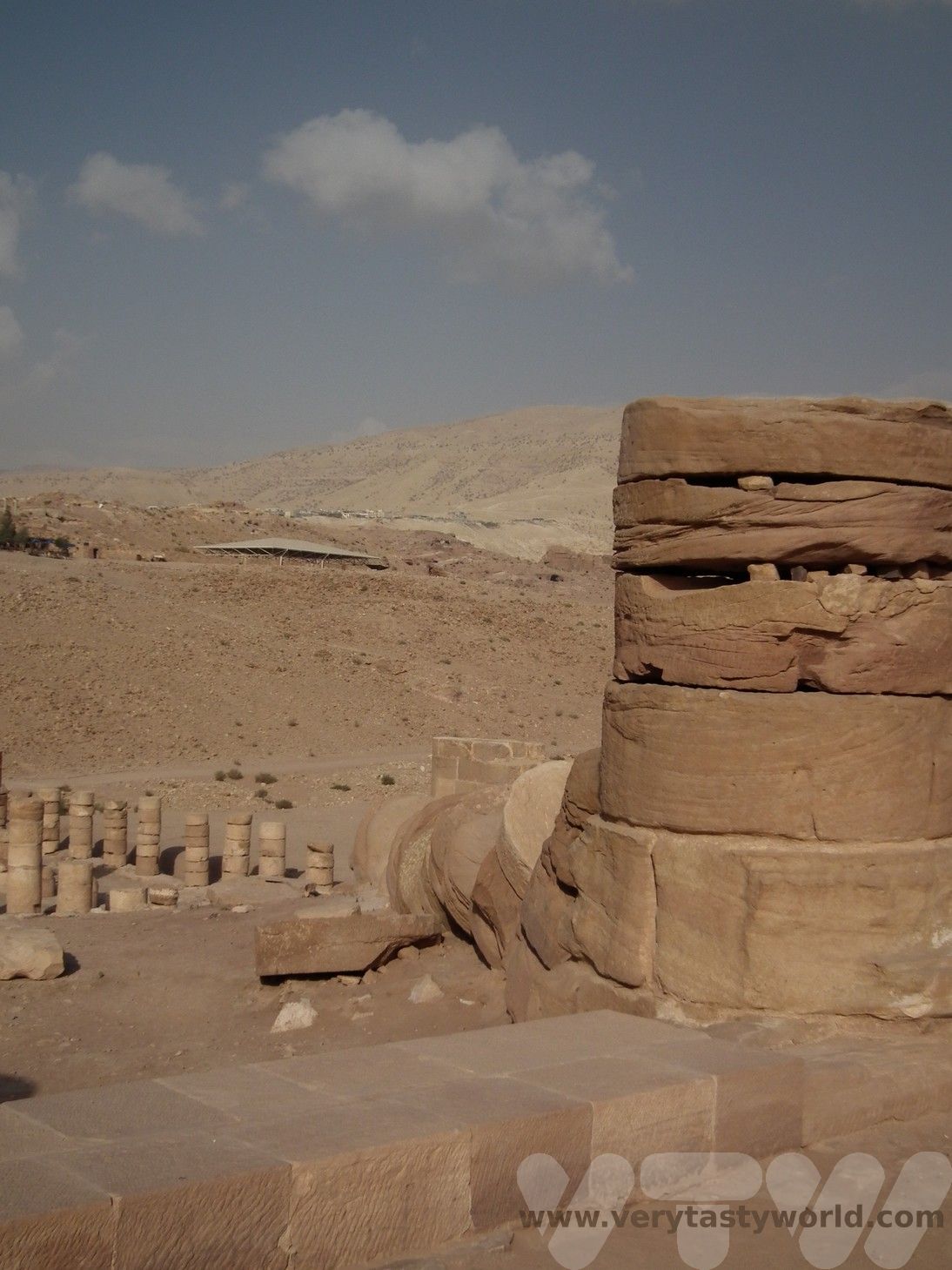
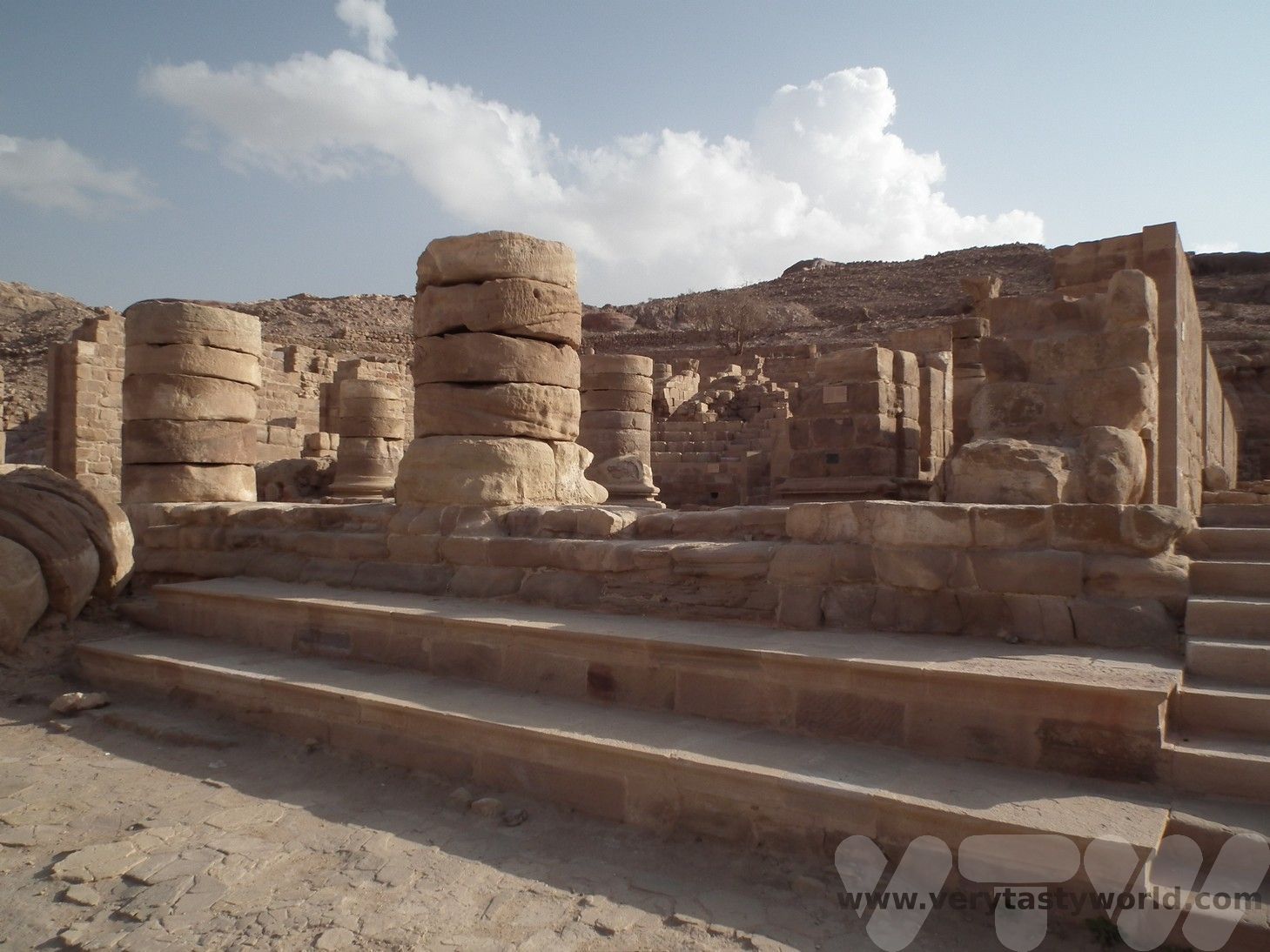
At the end of the street is the route to the Monastery.
The Monastery
We climbed 800 steps to Ad-Deir, The Monastery, which we found to be a moderate walk. It is classed as difficult on the trail guide because some of the steps have worn over the years. We needed to scramble a little on some sections.
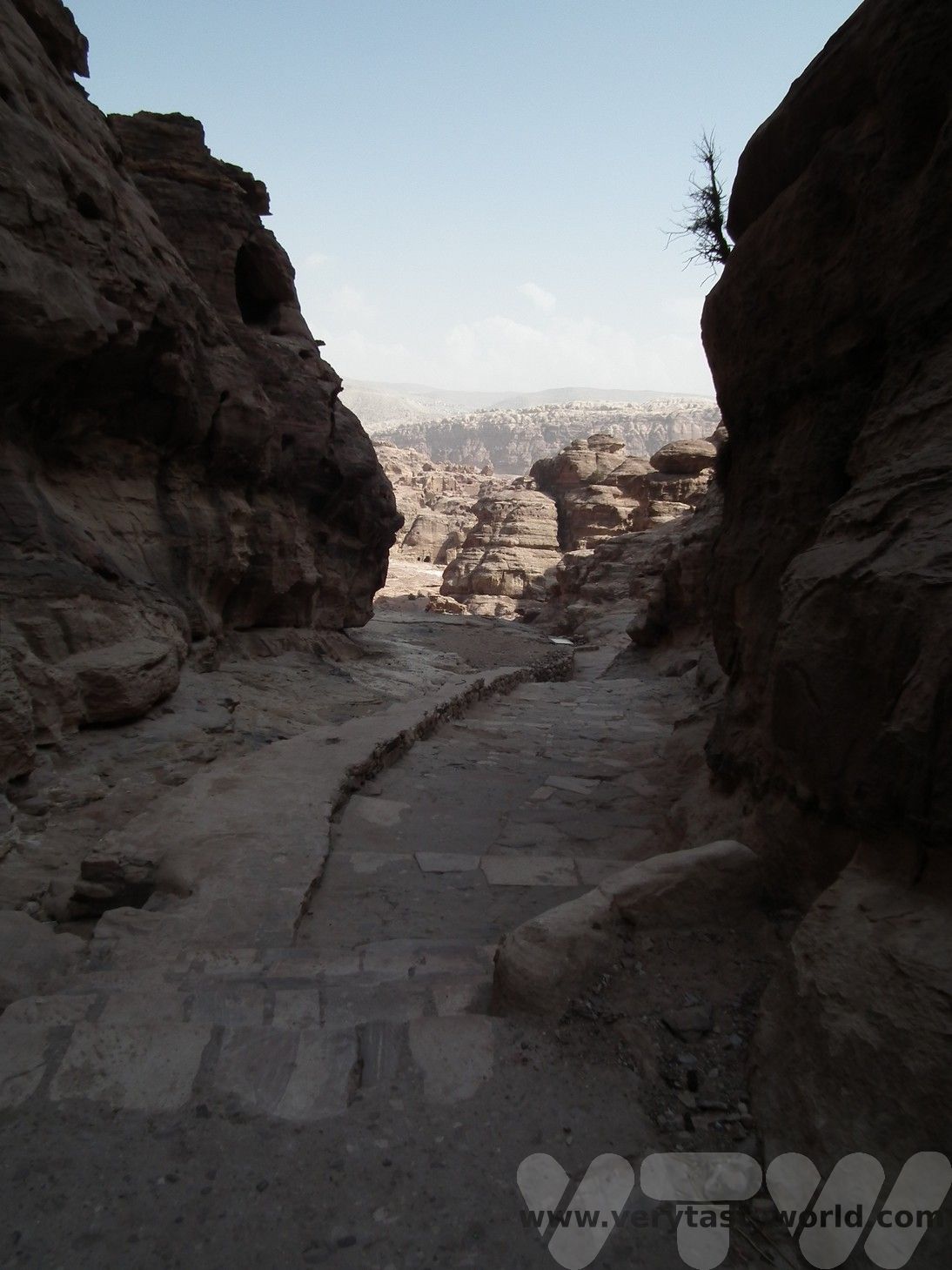
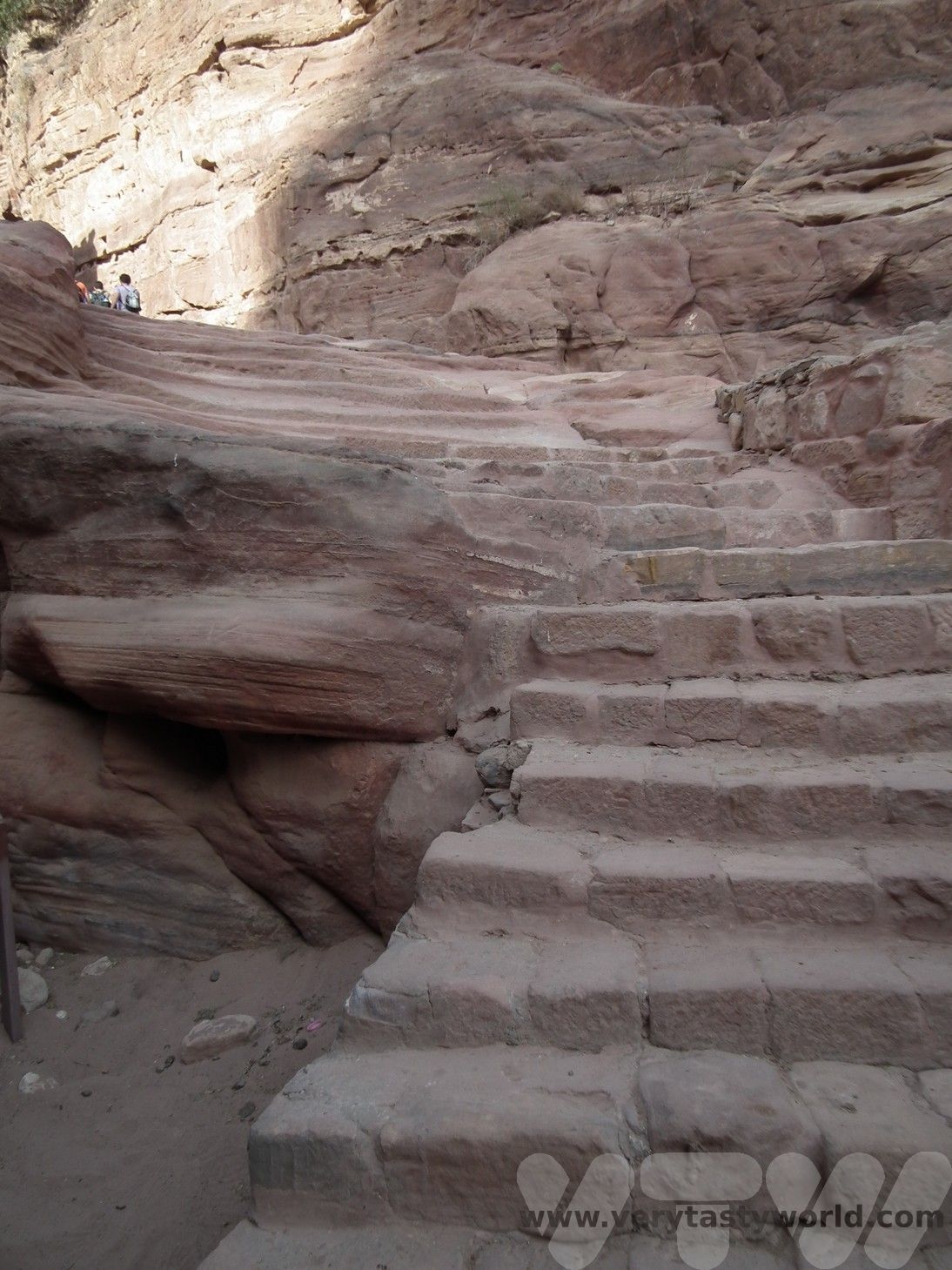
When we arrived we were delighted to discover that the Monastery was as spectacular at the Treasury.
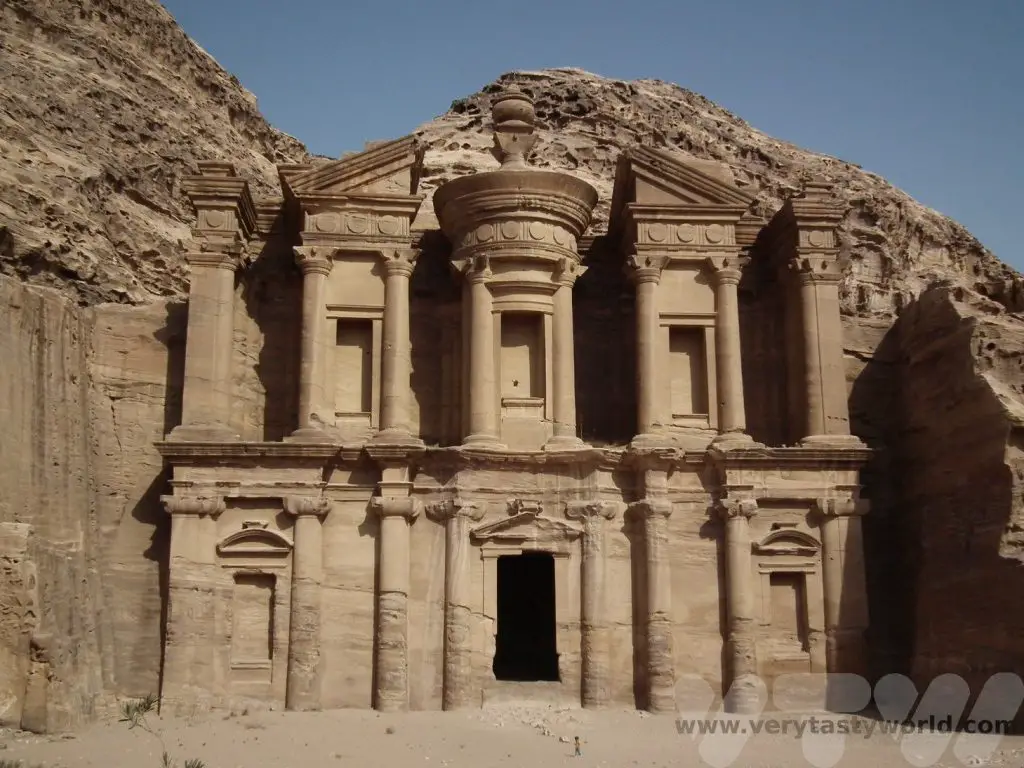
If you look closely at the photo below you can see a man sitting on the building, high up on the central colonnade. We had watched him climb all the way up the adjacent cliff face and then onto the building itself, leaping across the colonnades with absolute confidence – an amazing form of parkour. It was utterly terrifying watching him.
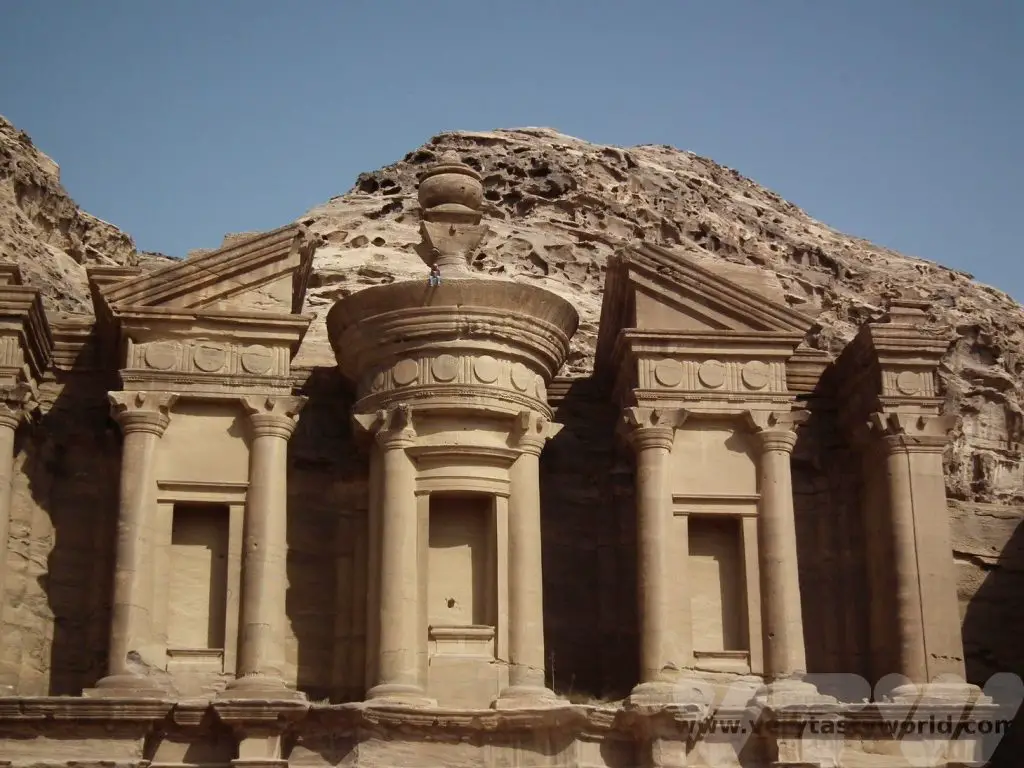
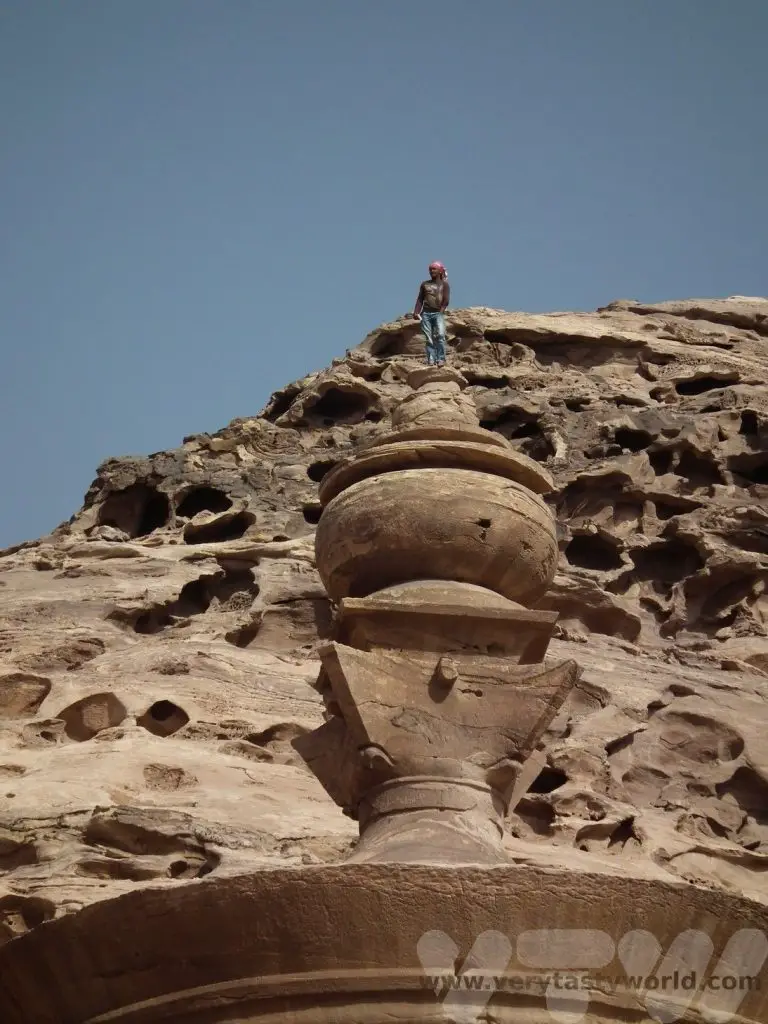
Exploring The Trails At Petra
There are numerous trails you can follow, some of which involve pretty tough climbs where the stairs have been eroded. The guide indicates the options available and the trails are well marked with brown signs.
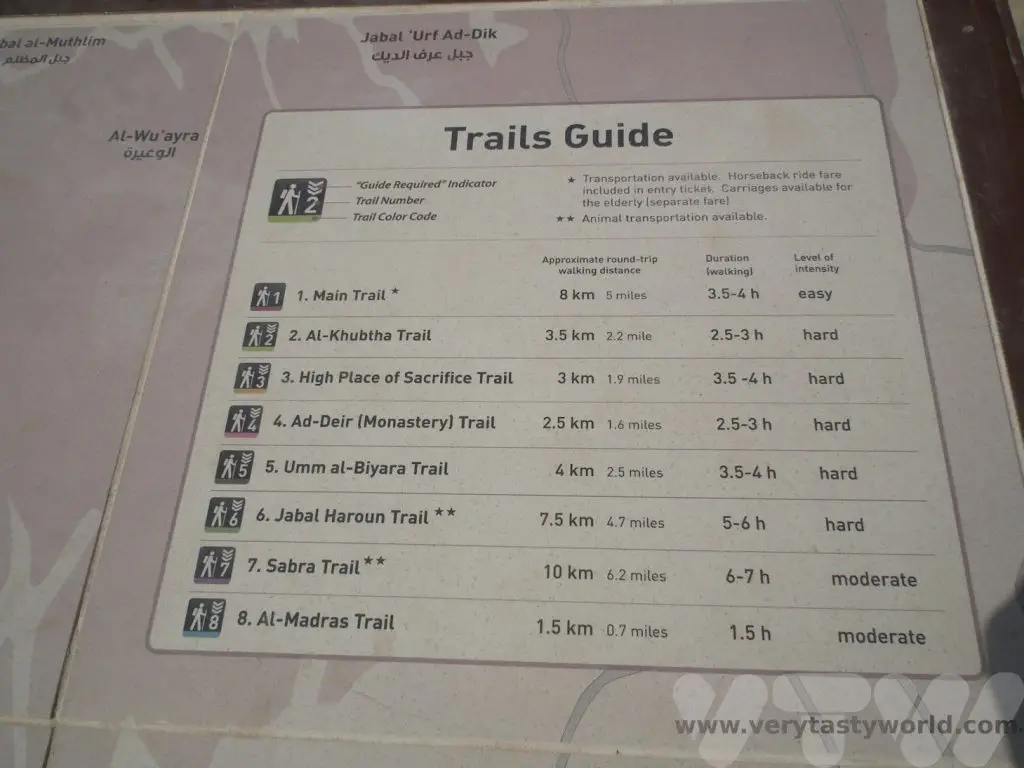
The other walk we did was the Al Khubtha trail, a climb to view The Treasury from above. We met a woman who was on her way down who said she had counted the number of steps, and sadly we can’t quite remember what her count was, but it was several hundred. The view was fantastic when we reached the summit.
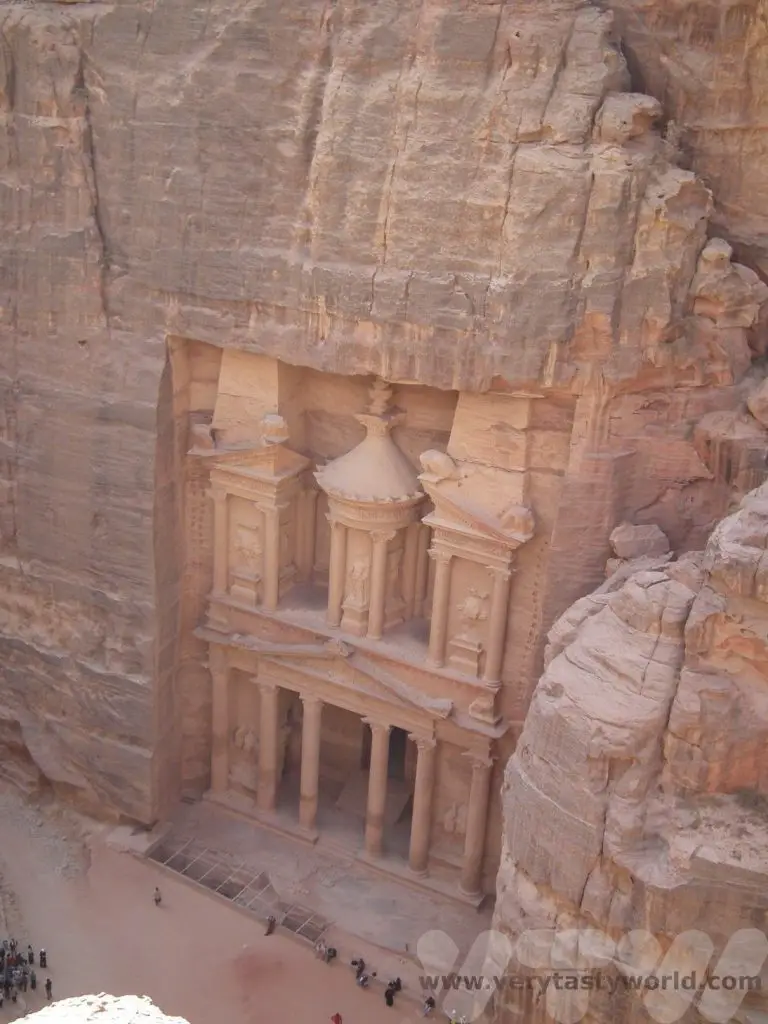
We also really loved the colours of the rock as we explored the various tombs. The white is silica, the red is iron oxide and the yellow, sandstone.
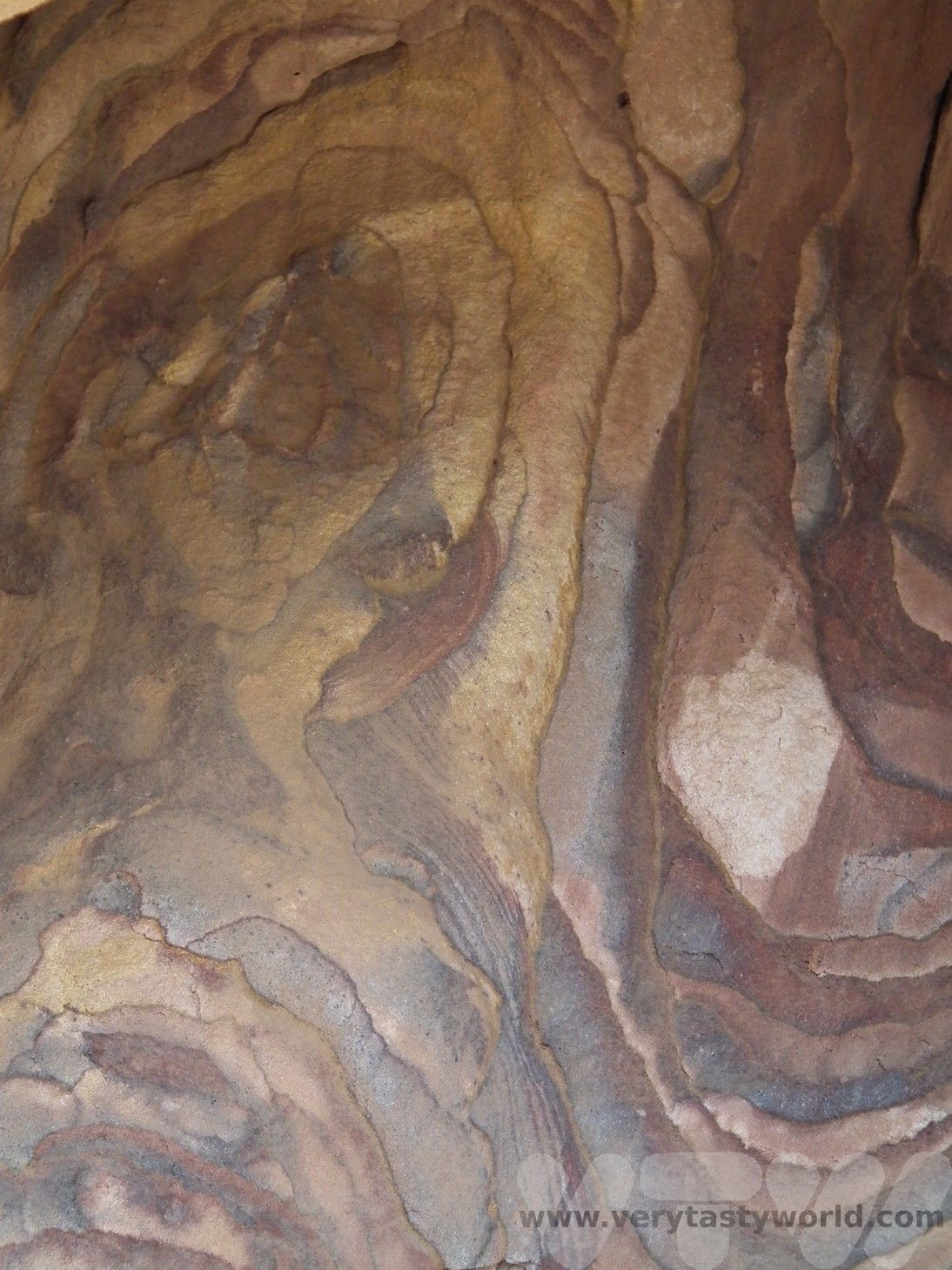
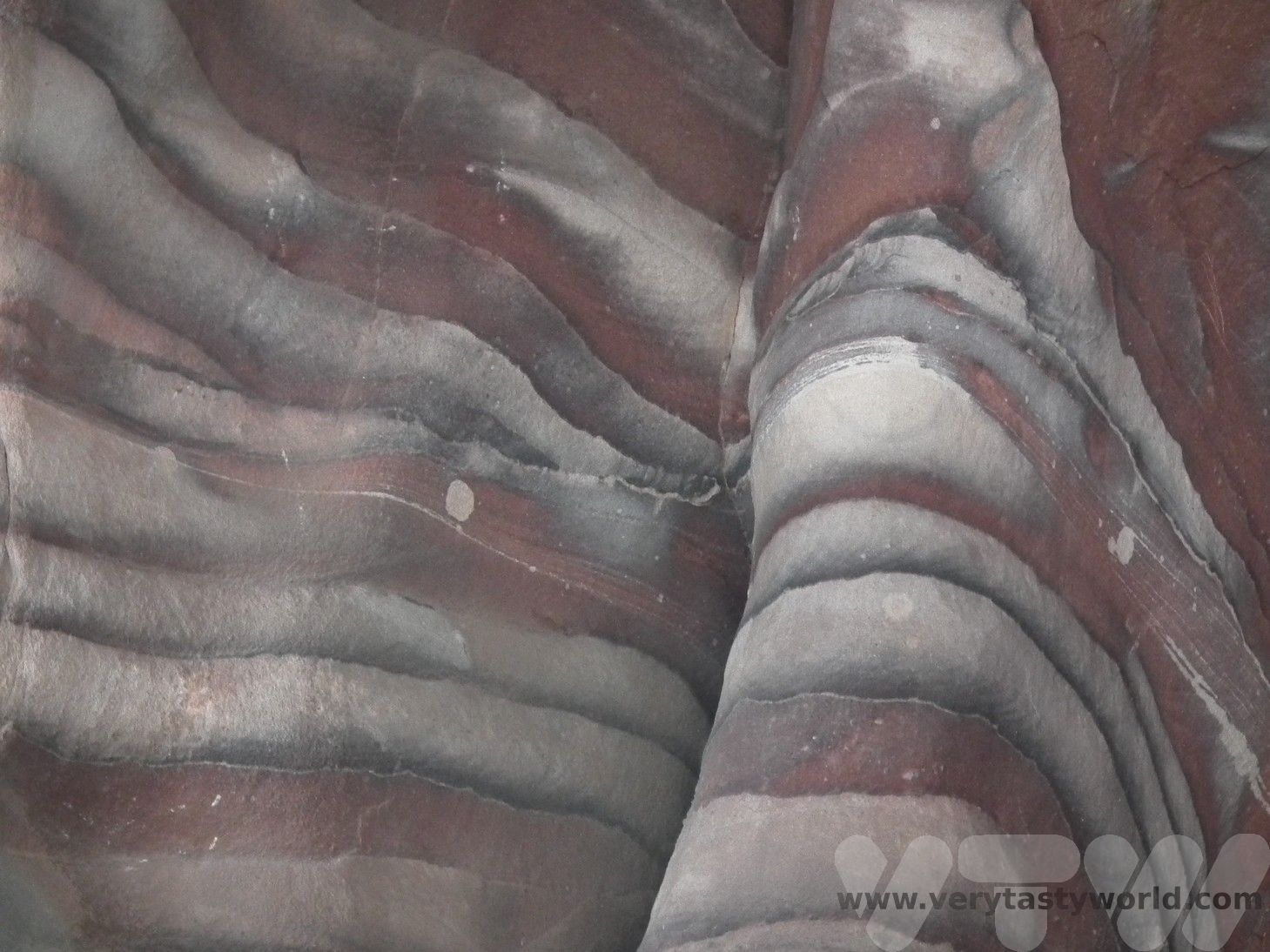
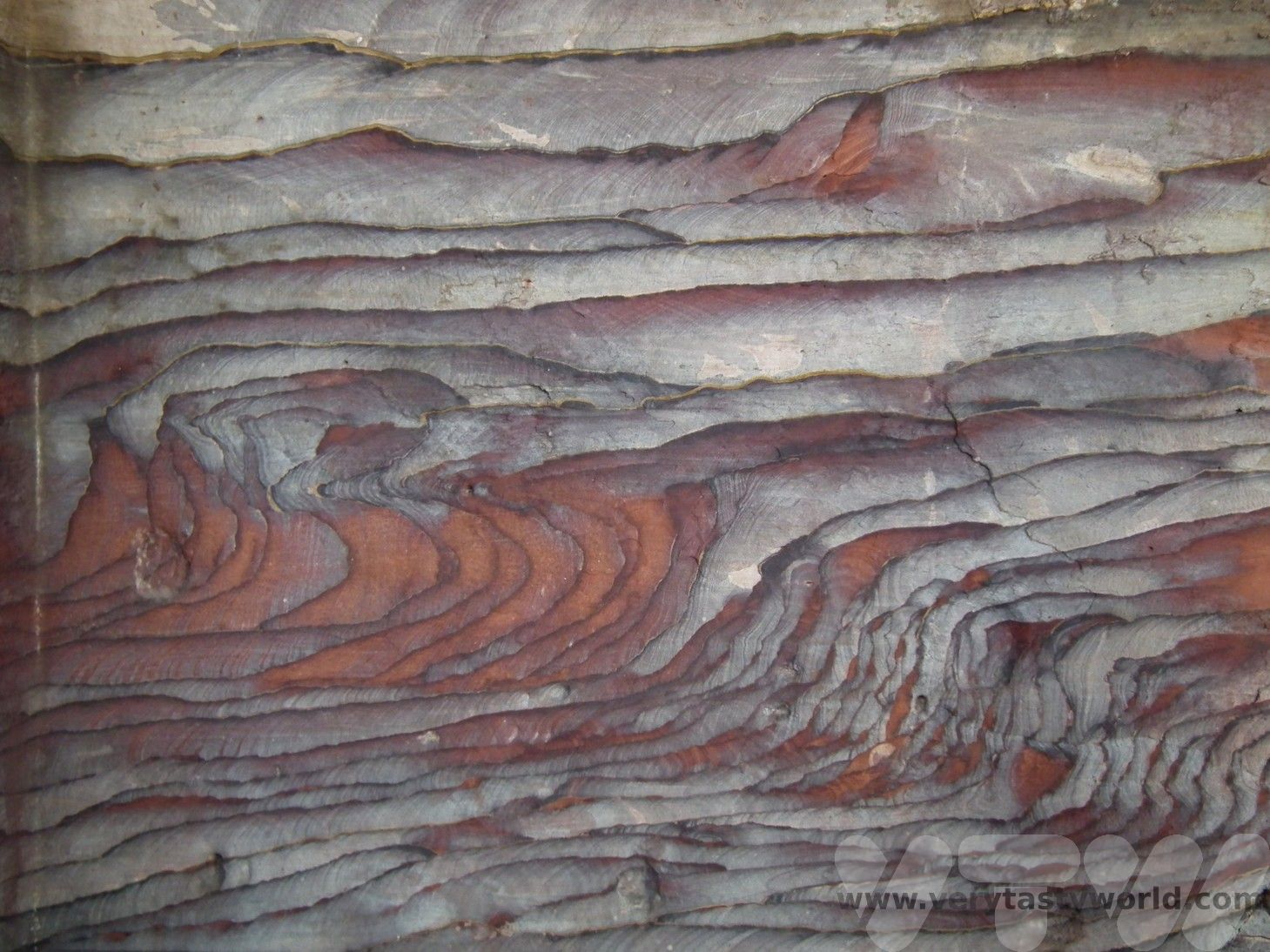
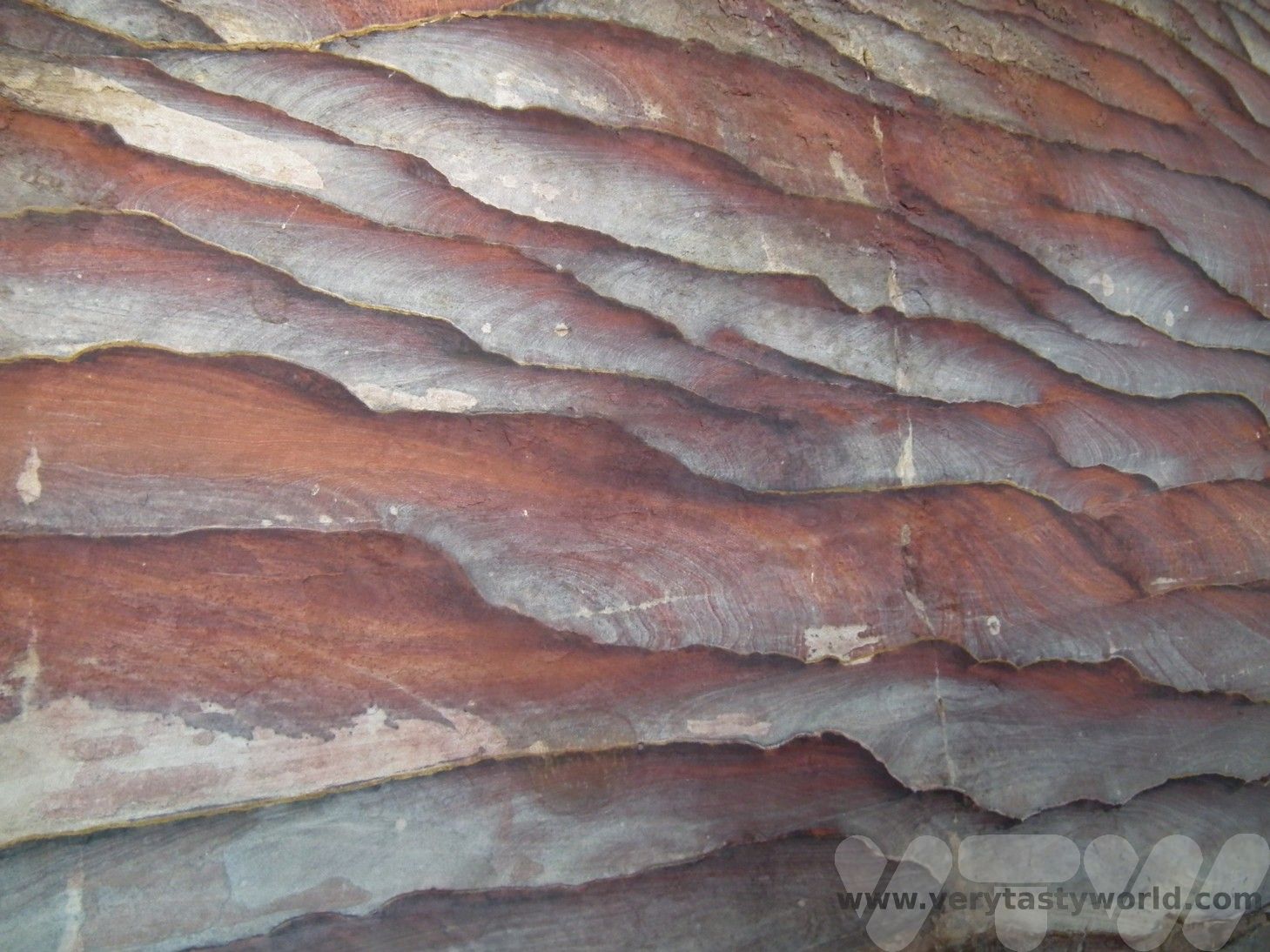
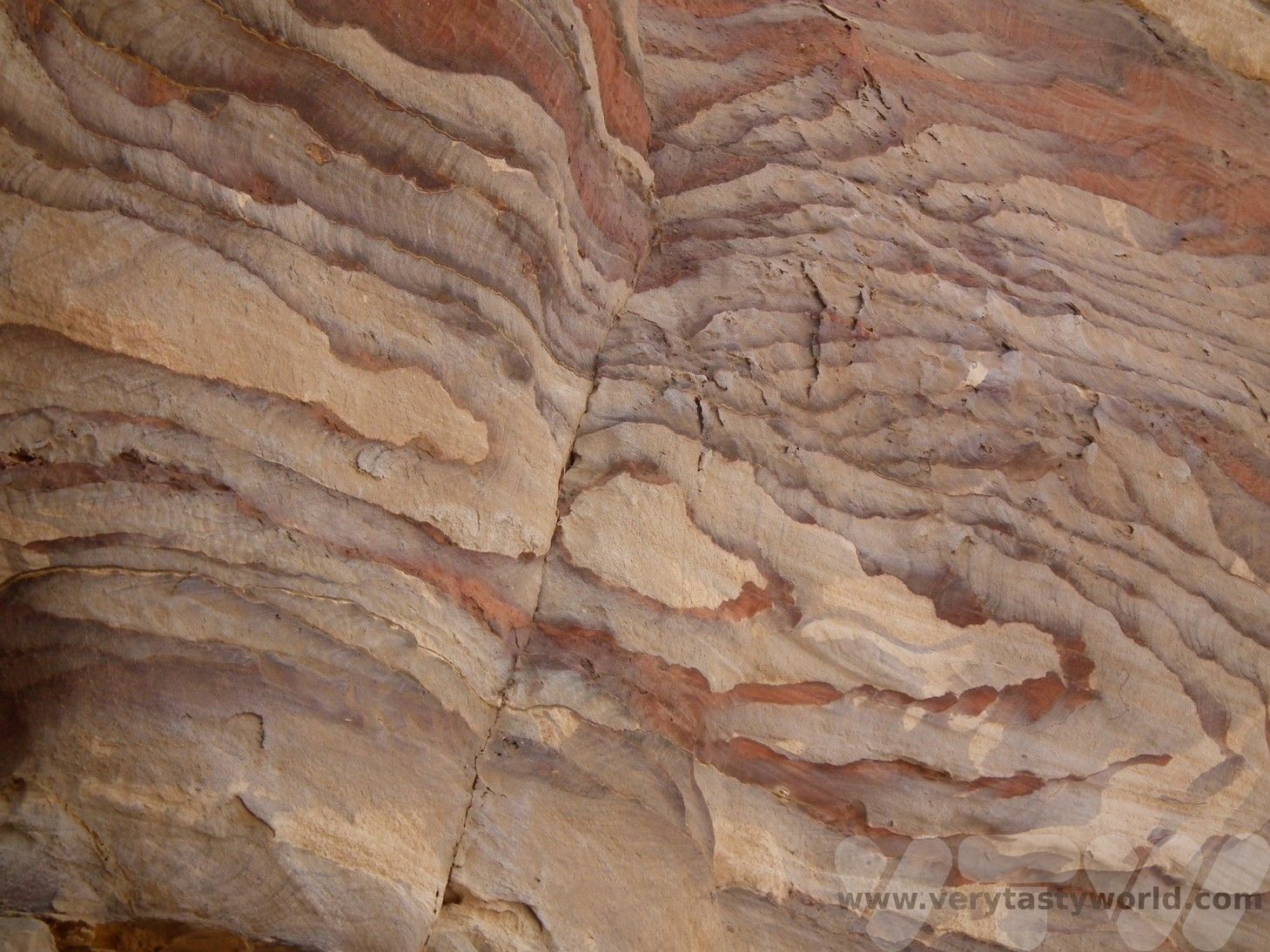
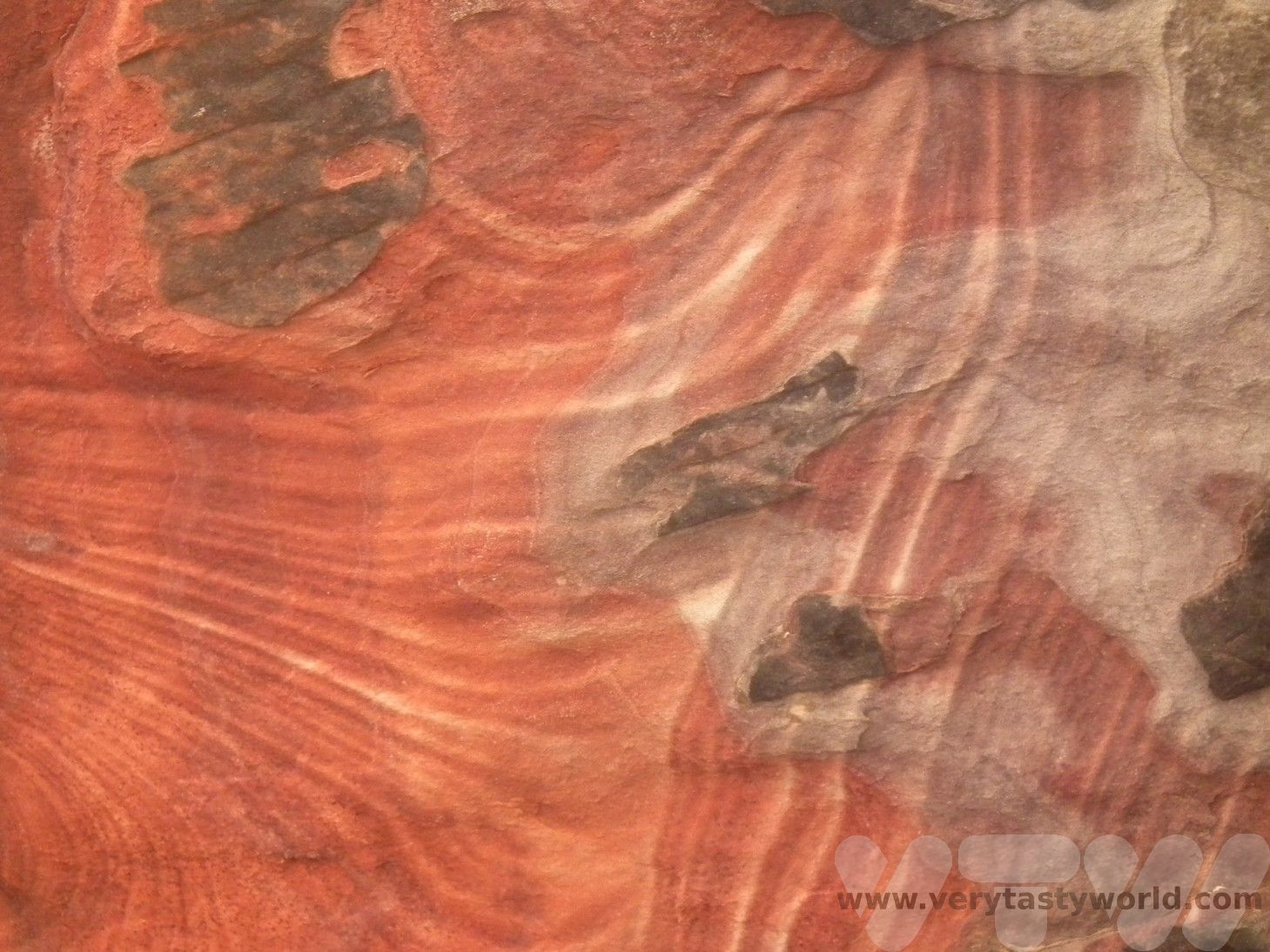
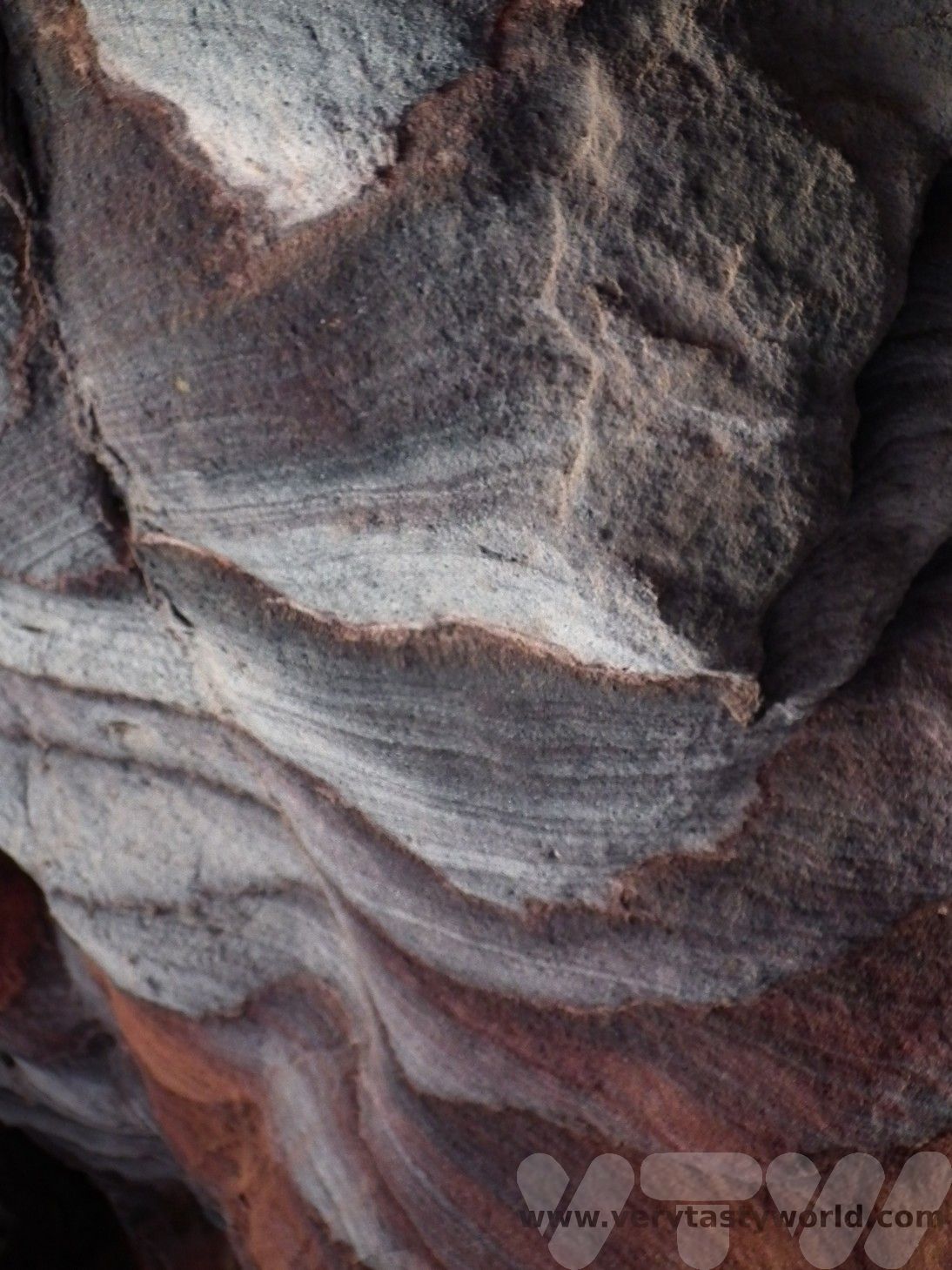
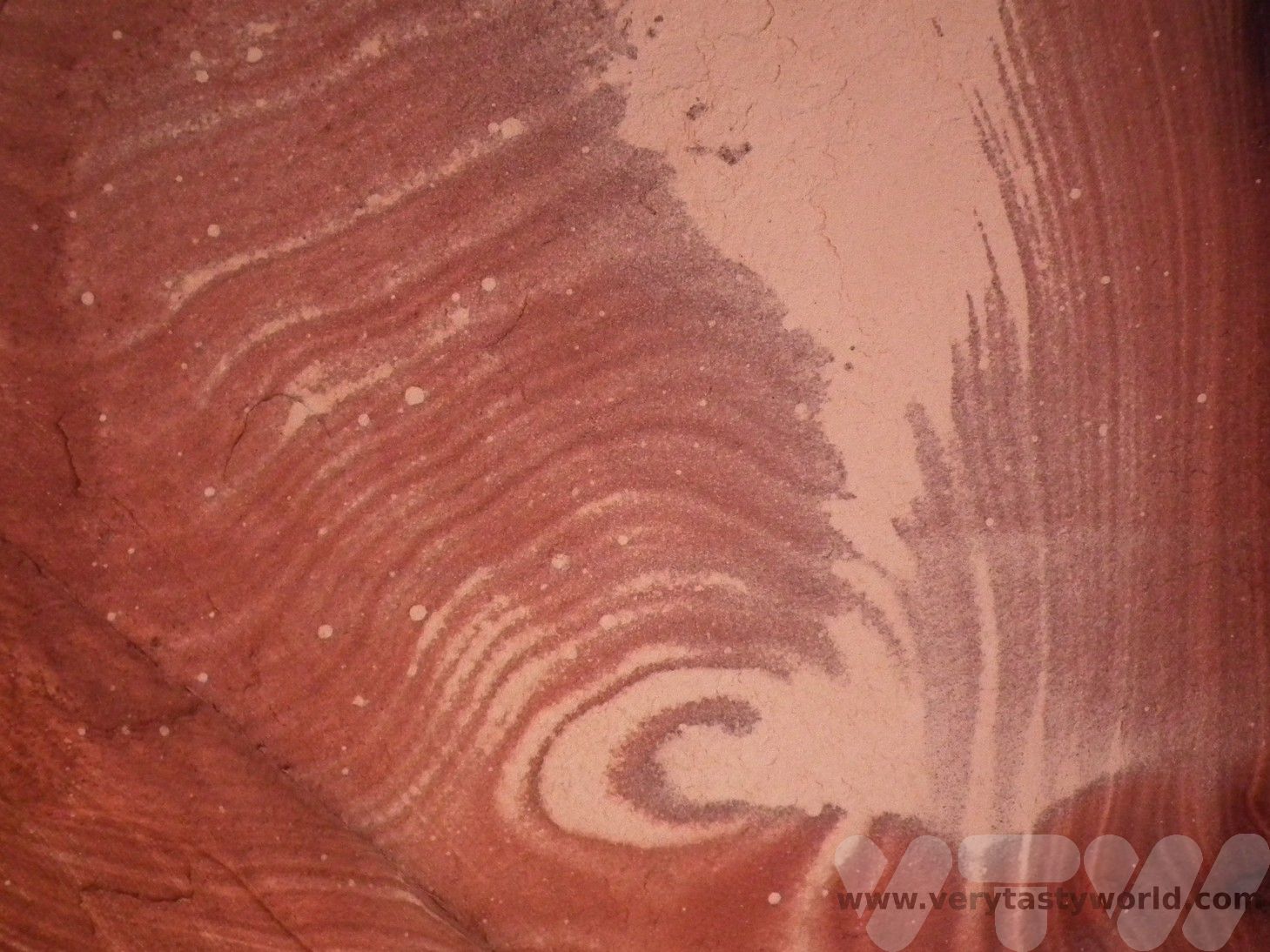
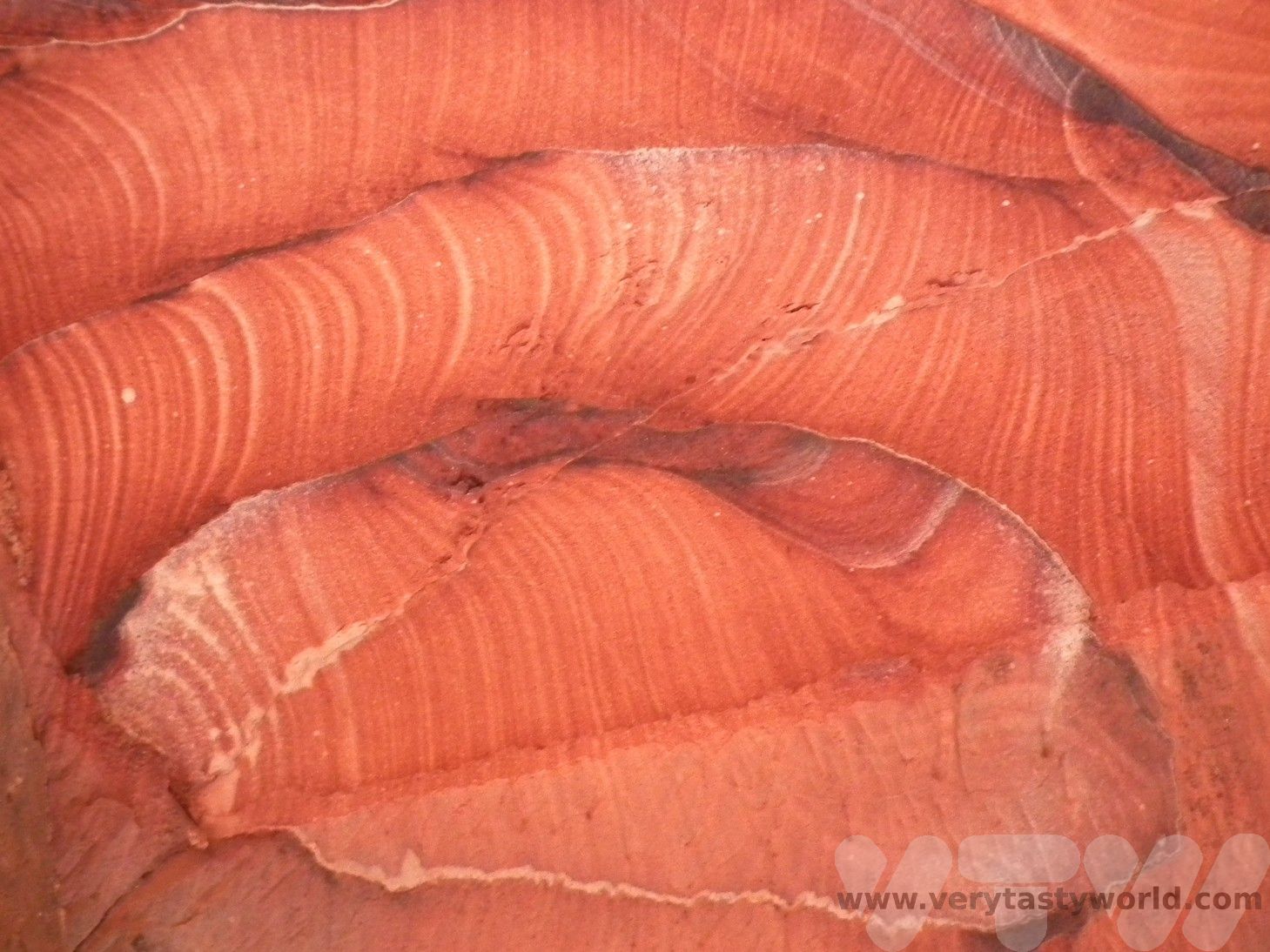
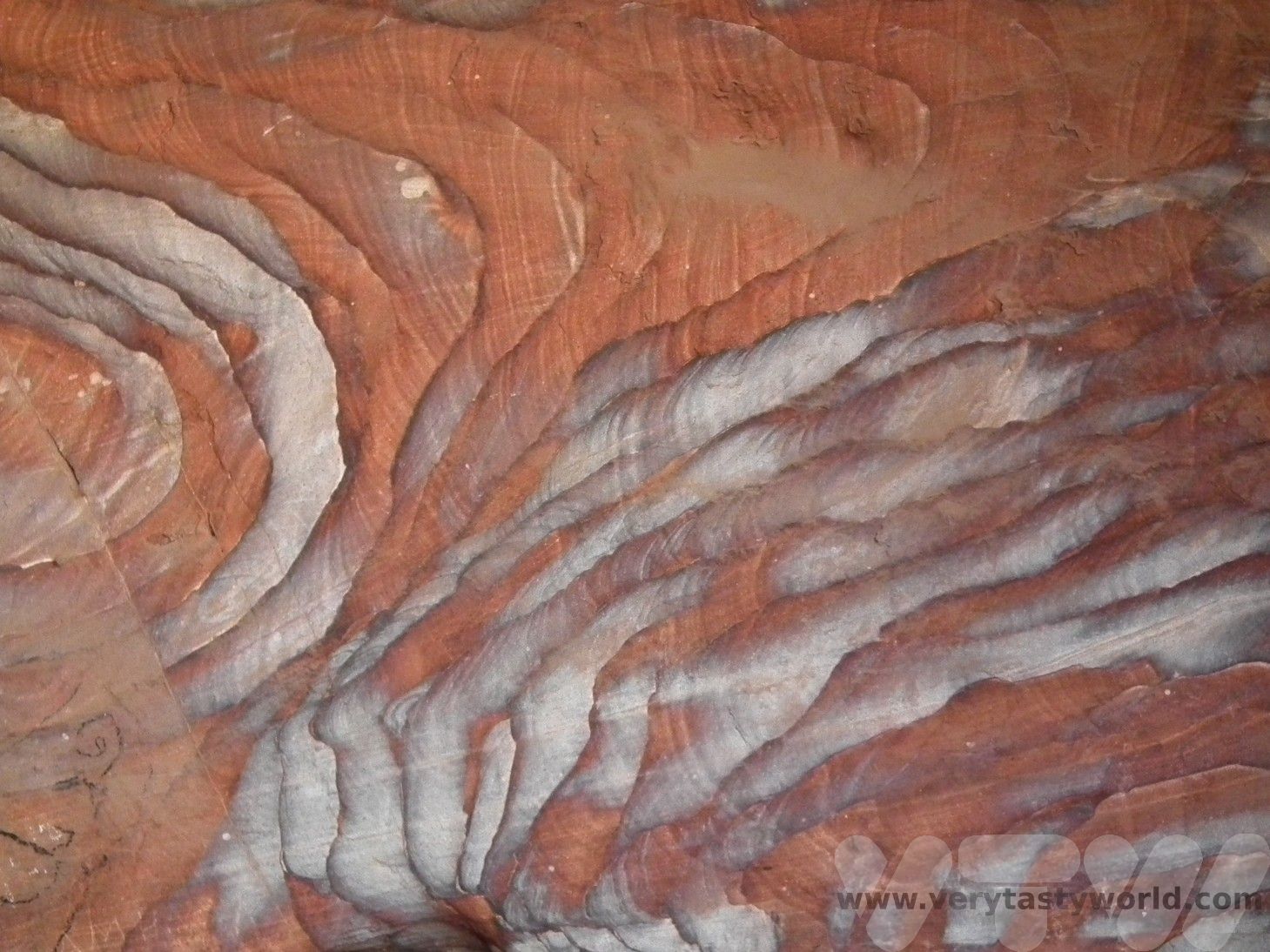
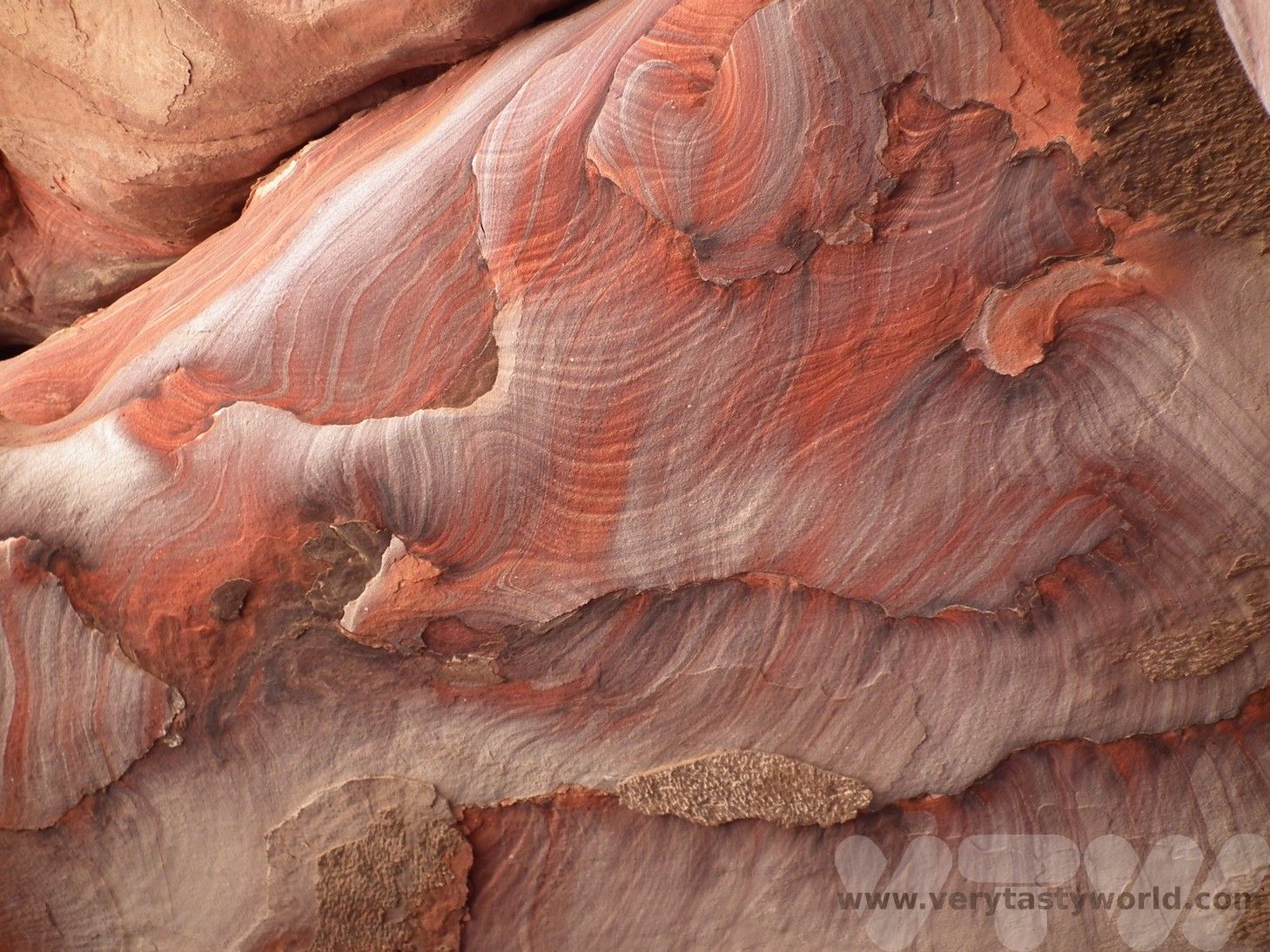
It is possible to see a night-time sound and light show at the Treasury. Walking through the Siq in the dark to see the Treasury lit up by lanterns is an ethereal sight.
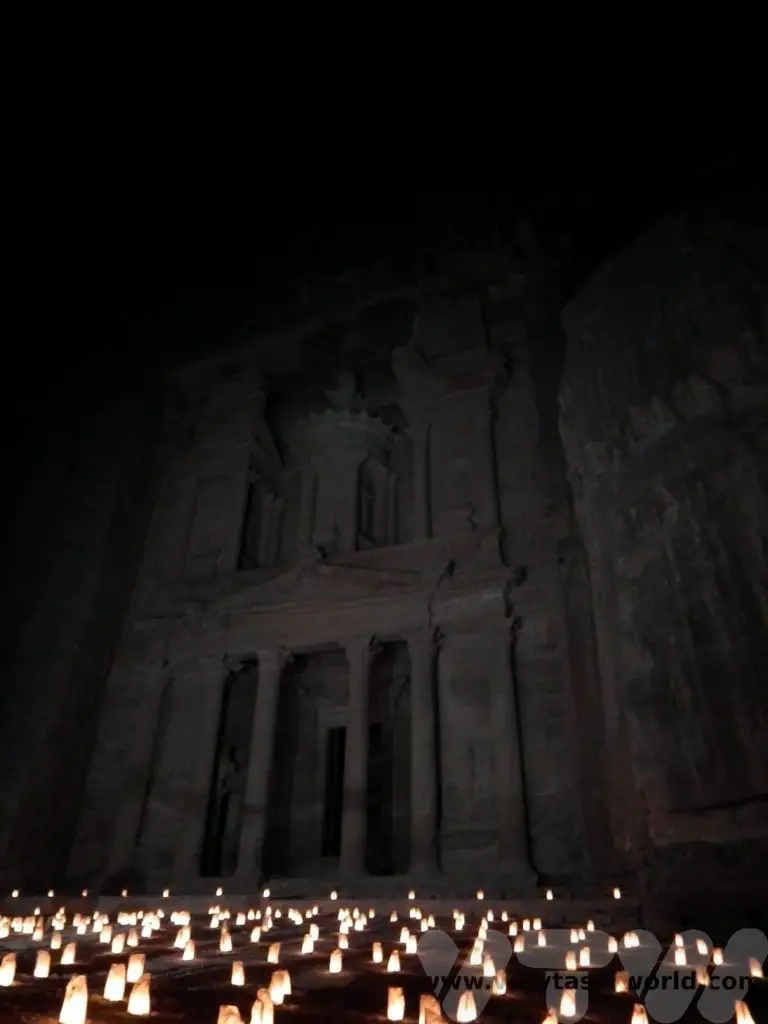
Practicalities To Visiting Petra In Jordan
There are restrooms on site at either end of the colonnaded street and nearby cafes which offer refreshments. We recommend the lemon juice with mint – it’s refreshing and delicious.
It’s advisable to wear a sunhat and use sun protection if you are exploring the walking trails as there is no shelter from the sun. Good walking shoes are advisable. Make sure you carry water with you. Use the bins provided to dispose of rubbish.
Keep on the trails. You may meet local people as you walk – we ended up chatting with some people on the Al Khubtha trail and were invited to enjoy a cup of tea with them. (We weren’t asked for money but we did offer a contribution towards the tea.)
After Your Visit To Petra – A Foodie Evening At The Petra Kitchen
After a full day’s exploring we were pretty tired and there’s not a lot to do at Wadi Musa. But we did manage to join a cookery course at the Petra Kitchen on one of the evenings. One of the chefs was the uncle of the guide who showed us around the site. We learned to make Jordanian food and then eat it – a fine way to spend an evening. We made Shourbat Adas (lentil soup), Baba Ganoush, Fatoush, Tabbouleh, Tahina salad, Galayet Bandora, Araies Iahma (Bedouin pizza – pittas stuffed with minced meat and covered with Galayet Bandora) as a mezza. The main course was Maqluba, an upside-down hotpot, which was scrummy. Sadly, we were too busy cooking – and eating – to take photos! But we do plan to cook the recipes at home and will no doubt blog about them in the future.
Related Posts You May Enjoy

Visiting The Dead Sea In Jordan
Taken with A Pinch of Salt
The Dead Sea is one of the strangest places on the planet. It is a salt lake located in a depression at the lowest place on earth, over 400m below sea level, which is bordered by Israel and the West Bank to the west and Jordan to the East. Visiting the Dead Sea in Jordan was an essential part of our itinerary on our journey through this fascinating country.
The area has an odd microclimate – it’s 10⁰C warmer at the coast than in the rest of the country. And the Dead Sea really is dead. At around 35% salinity it can’t support any life. Any unfortunate fish that happens to swim in there from the river Jordan lasts but moments. There is no activity on the water either – you don’t see any boats or water sports. The water is so saline it basically destroys machinery. The only thing you can really do there is bathe. And bathing in the Dead Sea is undoubtedly an experience.
The north end of the sea is mainly comprised of resort hotels of varying degrees of poshness, which have private beaches where you can do all sorts of spa type stuff, and the rest is rather beautiful coastline. We travelled along the shore on the Jordanian side on our way to the rose red city of Petra.
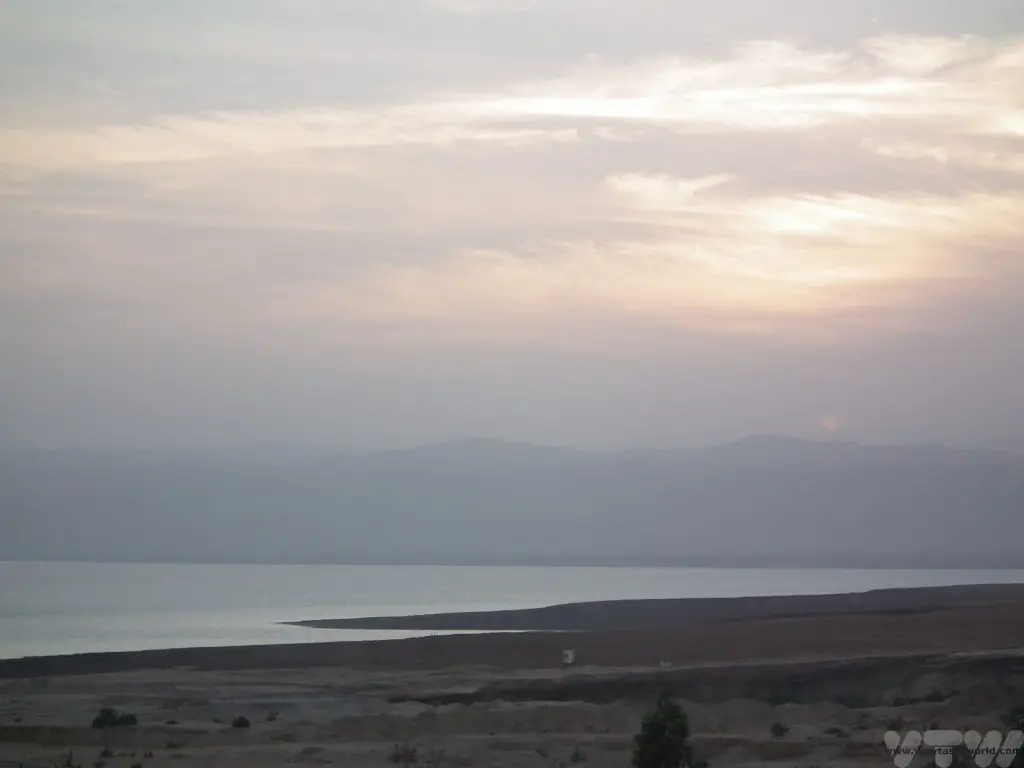
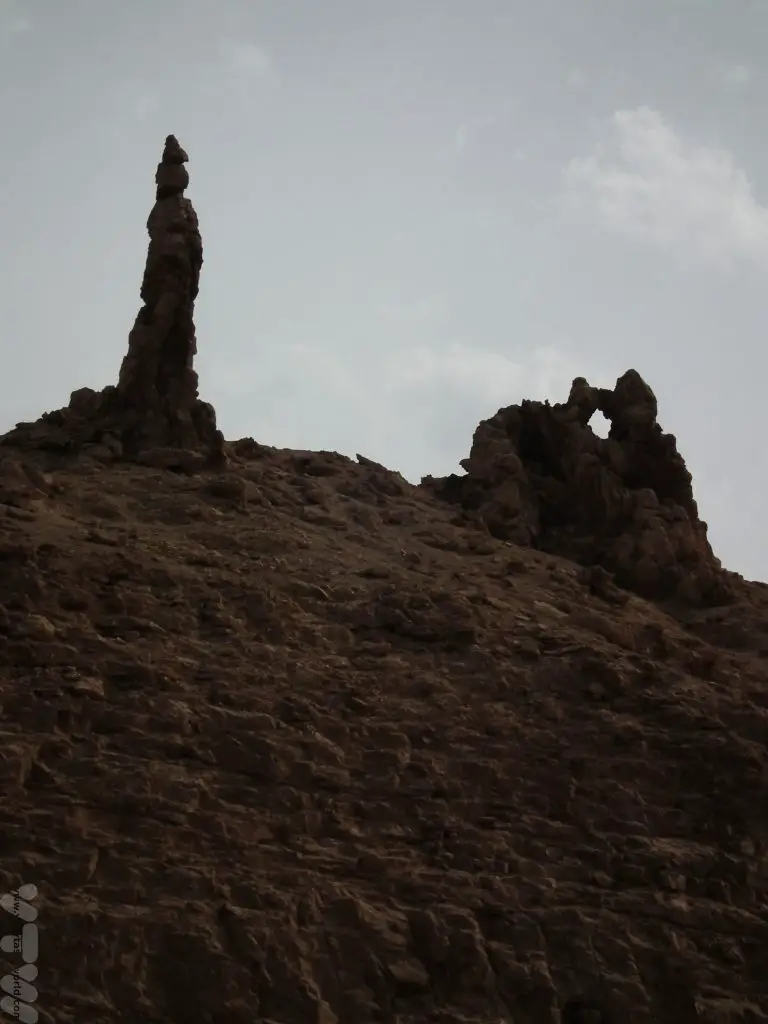
There is a pillar of salt, considered by locals to be Lot’s wife from the biblical story.
We decided to stay at a resort for just one night. The hotels on the north coast in Jordan are fairly self-contained and you are pretty much tied to the activities and restaurants there. For example, it was difficult for us to find somewhere to eat at establishments outside the resort and outside restaurants are more likely to cater to tourists. Our hotel had its own beach located about a two minute drive via a free shuttle bus (if you were lazy) or a ten minute walk from the swimming pools. Initially we wondered why there were pools when the purpose of our visit was to swim in the sea but it became clear later when we bathed.
Eternal Youth and Beauty?
Dead Sea mud apparently contains all sorts of minerals that are supposed to do wonders for your skin. And, like the Blue Lagoon in Iceland, you can buy a plethora of products containing miraculous mud at hugely inflated prices that are guaranteed to help you achieve eternal beauty. Or something. We headed down to the beach and caked ourselves in free mud from a bucket by the water’s edge before heading into the sea.
Bizarre Bathing
When visiting the Dead Sea in Jordan we absolutely had to bathe. It is impossible to sink in the Dead Sea. You walk in and keep walking. And then, when the water is about at chest height, you take another step and realise that you should be able to touch the sandy floor, but you can’t, yet the water is still at chest height.
It is also impossible to swim in the Dead Sea. When trying to do a simple breast-stroke you are so buoyant that your bottom kind of flips up, pushing your face into the water, which is a really bad idea because if you get any water in your eyes it stings like crazy. You know that feeling when you’ve been chopping chillies and forget to wash your hands and then brush your eye? That burning agony? Well, it’s ten times worse if you splash Dead Sea water in your eye. The water feels oily and hurts like hell.
The easiest way to bathe is simply to float in a sitting position. It’s very comfortable. If you want to move around, sculling gently seemed to produce the required propulsion. We didn’t take pictures of ourselves reading books or anything but it really would be perfectly possible.
When you emerge from the sea you really need to shower off quickly and get all the salt off your skin and bathing suits. Any fabric splashed with water becomes stiff as a board and encrusted with salt. Fresh water showers are located on the beaches, not far from the shore, so that you can clean up quickly.
We’re not convinced that the mud did endow us with eternal beauty but bathing was an most definitely an interesting experience.
Natural Beauty of the Dead Sea
What was truly beautiful was the salt-encrusted shoreline.
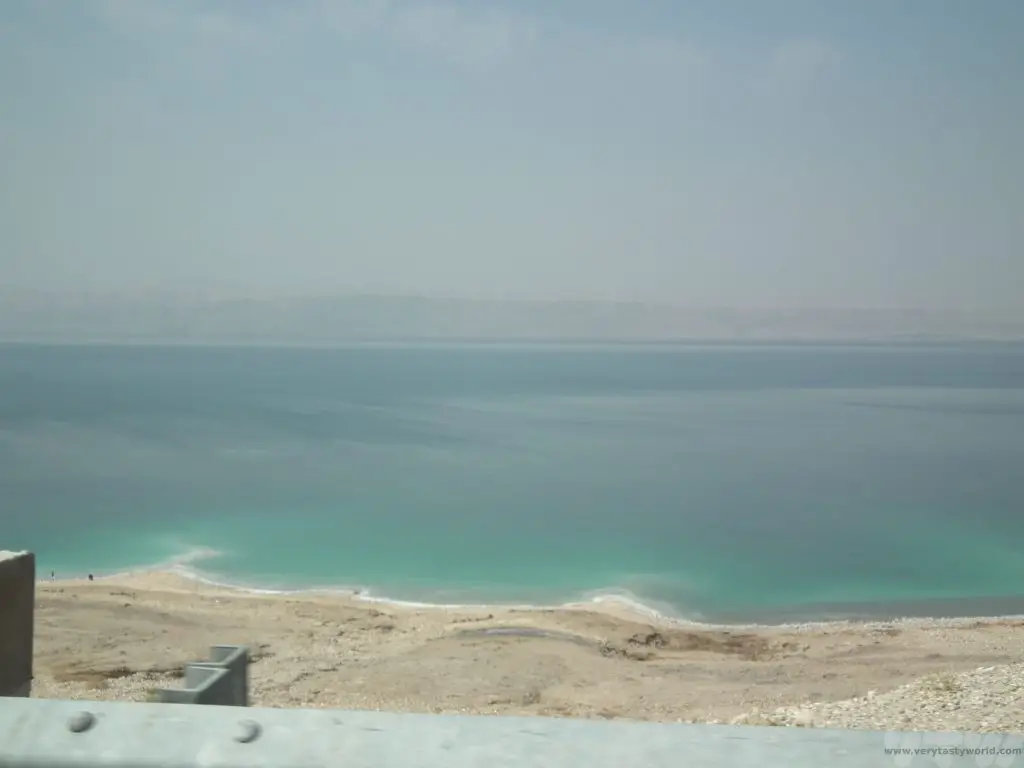
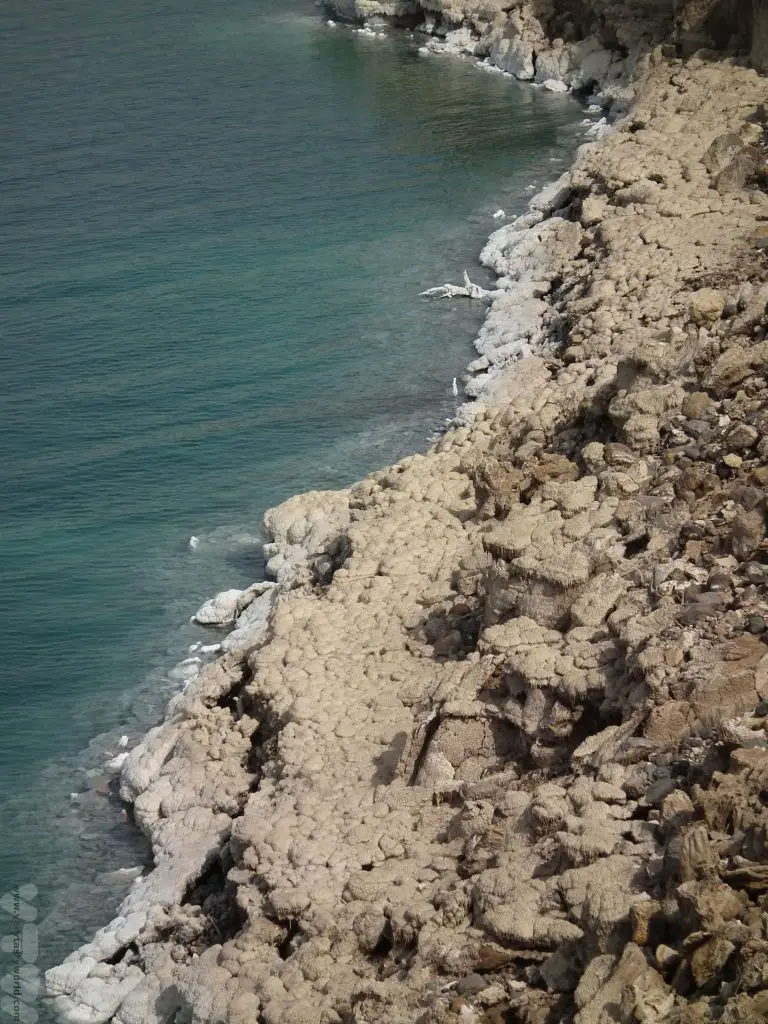
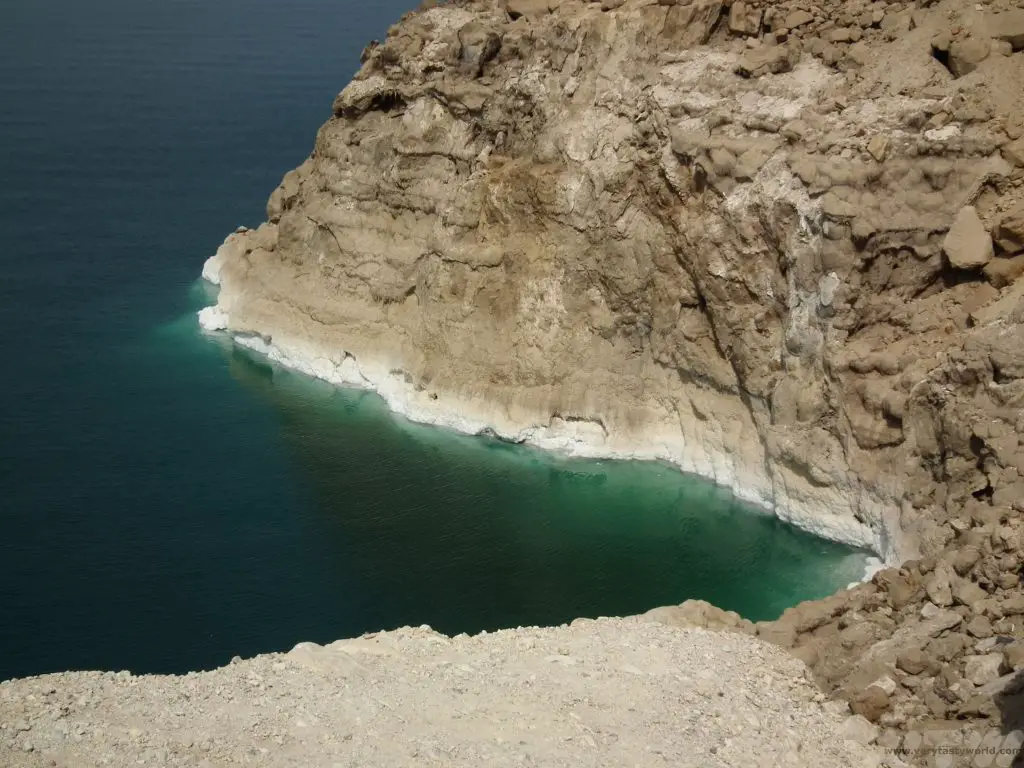
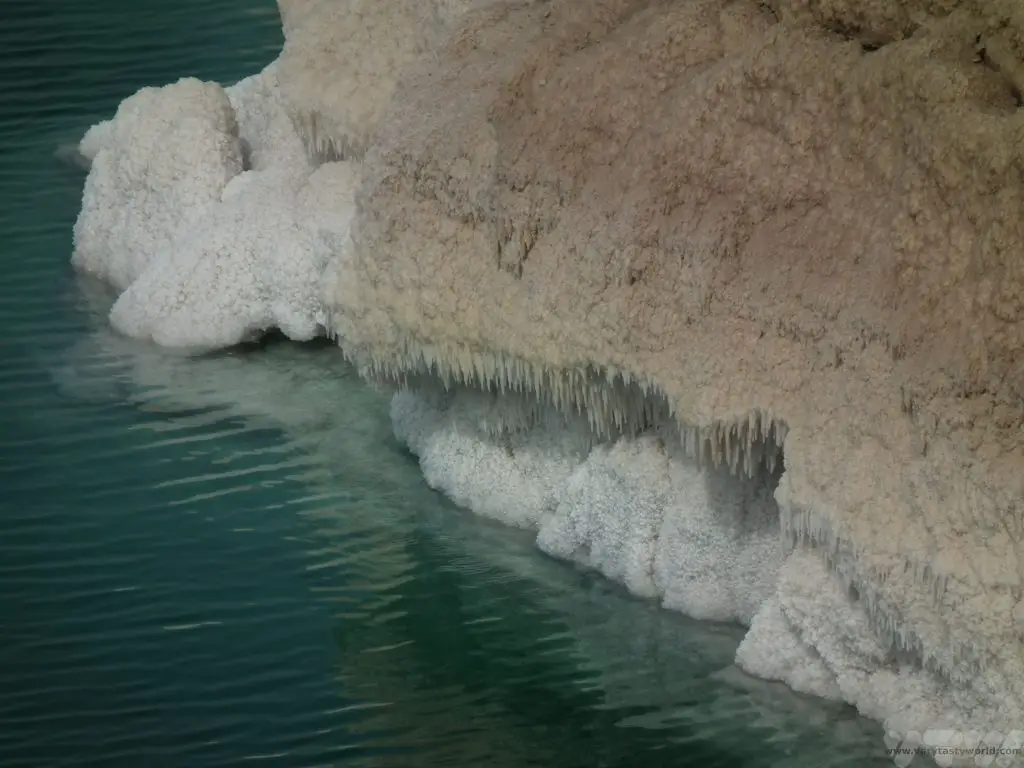
We did wonder whether Dead Sea salt was edible as most sea salt can be used for seasoning and preserving. However, the merest (accidental) taste of Dead Sea salty water will confirm beyond any doubt that in its basic form it tastes revolting. The mineral composition is very different to standard sea salt, and tastes extremely bitter, so processing is needed to remove these in order to ensure safe – and tastier – use for human consumption.
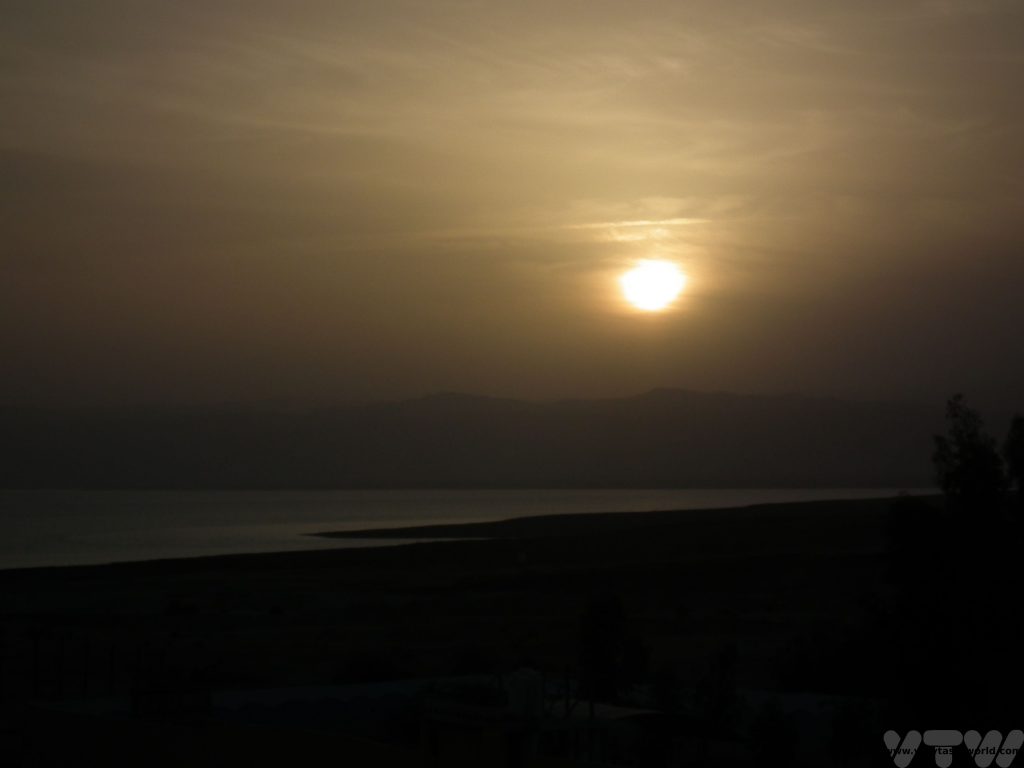

The Roman Ruins in Jerash, Jordan
Roman Streets and Sweet Treats
The Roman ruins at Jerash Jordan are some of the best preserved in the world. Jerash is within an easy 50-ish km drive of the capital Amman. The site makes for a fascinating day trip; covering a very large area it is possible to wander all over the city. It is definitely worth finding a guide who can point out all the features and explain the history and the architecture, especially as there aren’t many signs or information points, although beware as they may encourage you to buy stuff you don’t really want to buy from various vendors who can be found waiting for tourists.
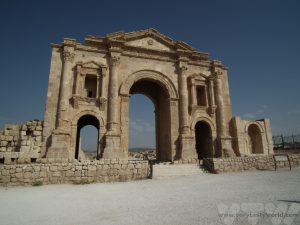
The arch of Hadrian (who had already started construction of the wall in the north of England) was erected around 129-130 AD , when the Emperor visited Jerash.
The hippodrome was an enormous arena which was used for chariot races and gladiator fights. Sometimes chariot races are re-enacted in the space. Sadly, not when we visited.
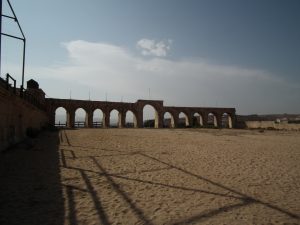
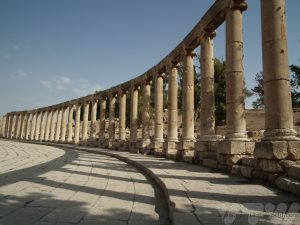
The colonnaded forum, an area designed as a marketplace but used for social gatherings, including important political meetings, is stunning. Its oval shape is very unusual.
The nymphanium, a monument to the nymphs, was fed by an aqueduct.
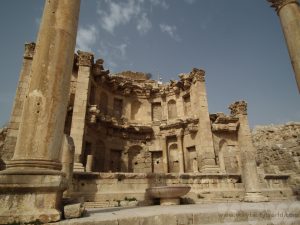
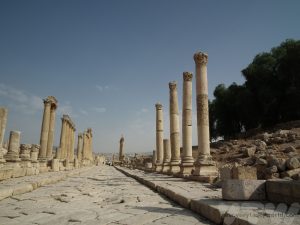
It’s possible to walk down the roman street, also known as a cardo and as straight as Roman roads are reputed to be, again lined with columns. The road’s surface is original.
There’s an amphitheatre where you can stand on the stage and let your inner thespian out. Even if you don’t feel up to a full performance of your favourite speech, it’s worth standing on the stage and just speaking – the acoustic design of the theatre ensures that your voice can be heard with remarkable clarity, even normal speech levels.
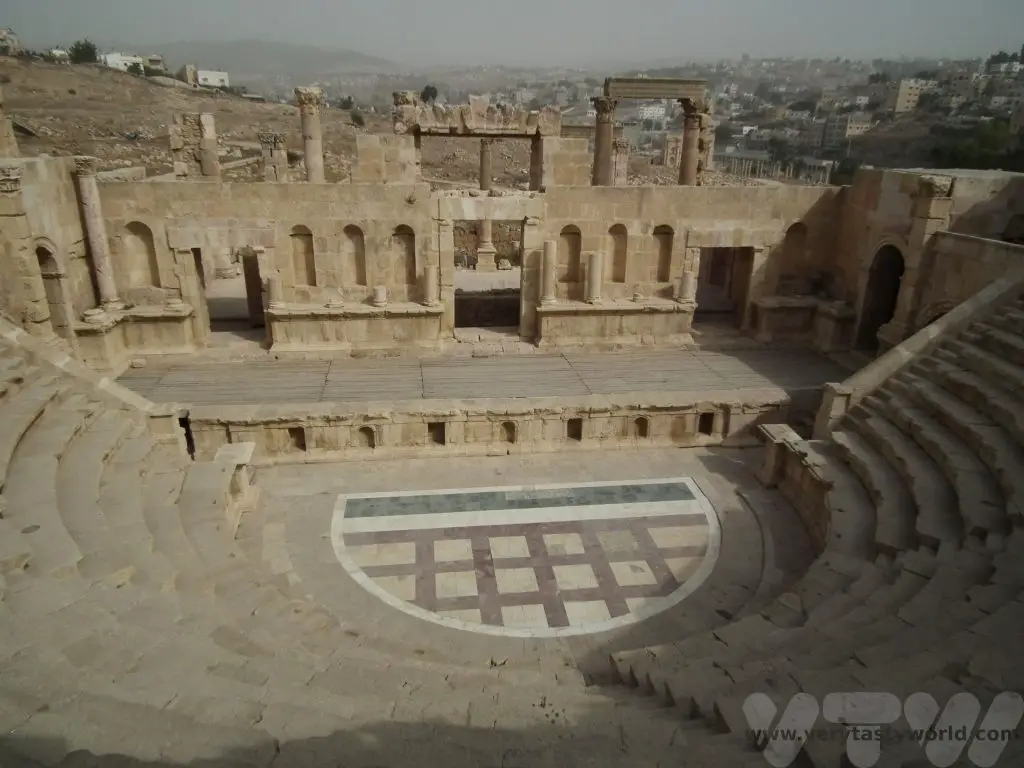
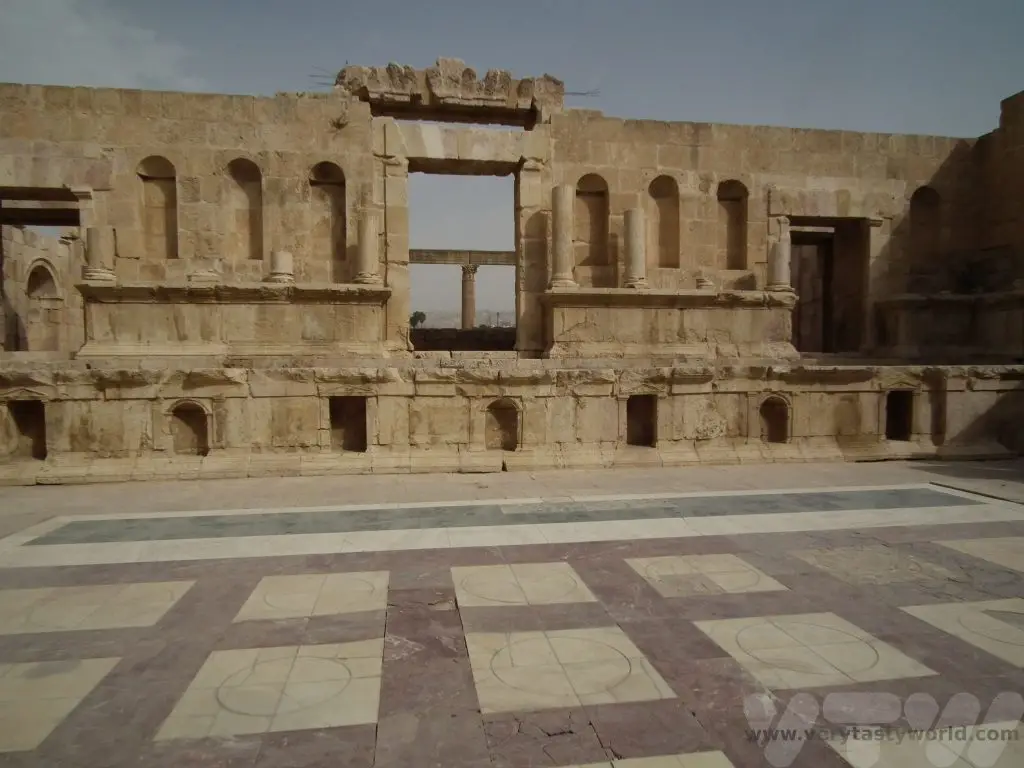
And at the end of a day’s exploration of the Roman ruins in Jerash, you are likely to be peckish. We were. Amman has some really excellent restaurants so on our return to the capital we went to Habibah to eat kanafeh.
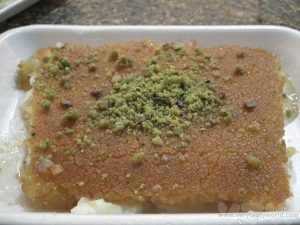
Other Posts You May Like
Jordanian Dessert – Kanafeh at Habibah
Middle eastern desserts are not only delicious they are also quite addictive. One of the defining elements of a Jordanian dessert we tried when visiting the country was the sweet, sweet syrup that soaks into and pervades the pastry or dough that forms the base. The sweetness is probably a good thing as it does limit your ability to scoff vast quantities of these scrumptious sweets.
The magic ingredient in Kanafeh is cheese. Kanafeh comprises pastry or dough, saturated in syrup and layered with a very slightly salty cheese, traditionally nabulsi or akkawi, which adds a comforting and savoury contrast to counterbalance the sweetness. Kanafeh can take a variety of forms – some use vermicelli type noodles as the base, others a pastry type dough. The syrup can be flavoured with rose or orange water to give a light fragrance to the dessert.
Habibah in Amman have been in business for several decades. It’s easy to see why. They specialise in Jordanian dessert and their kanafeh is superb.
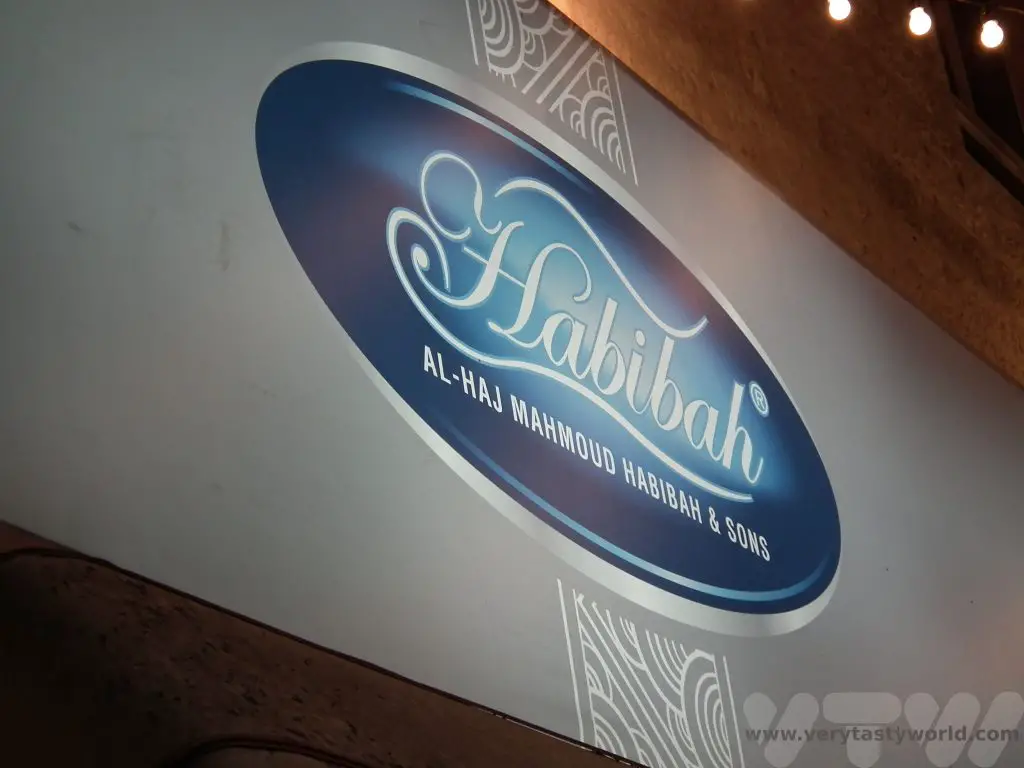
The kanafeh we tried was based on a pastry dough with layers of cheese. Topped off with pistachios for crunch and a nice green colour, and served warm, it is an absolutely delicious way to round off any meal. Or you could just order a really large portion and eat that instead of a meal – it’s worth it.
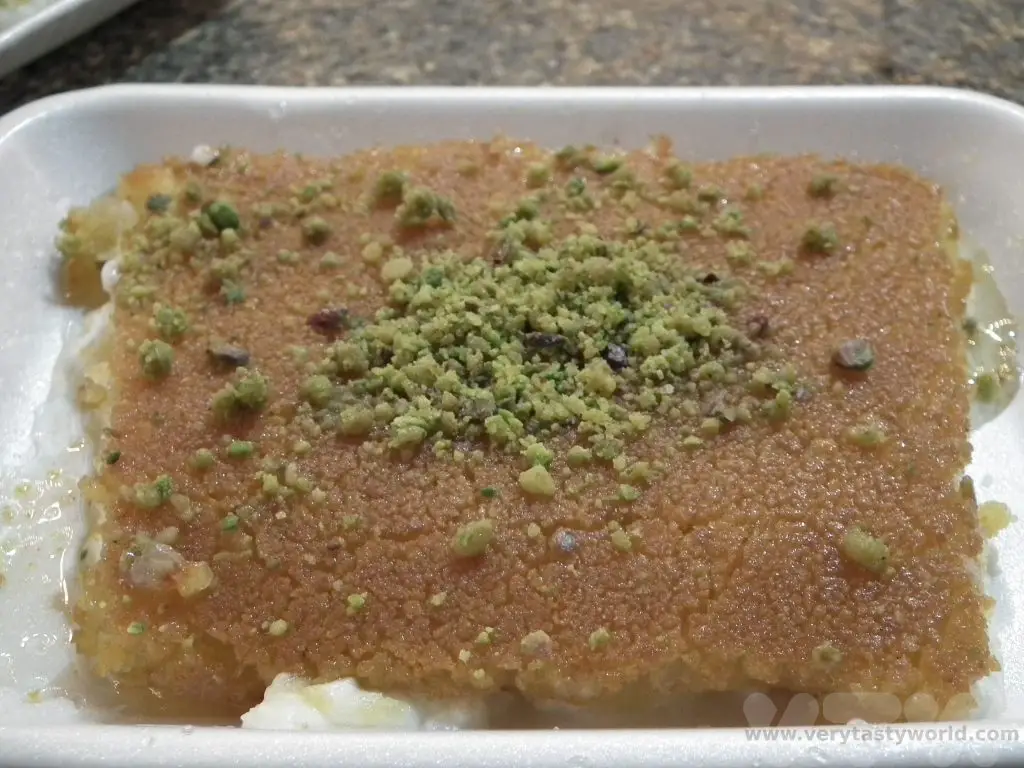
Related Posts You May Enjoy

